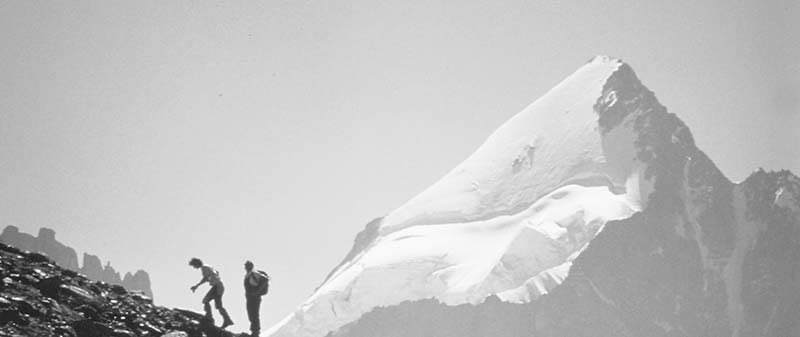
Annecy • Chamonix
Chamonix Activities at a Glance
The Savoie region grows Europe’s highest mountains and is the penthouse of the French Alps (the lower Alpes-Dauphiné lie to the south). More than just a pretty-peaked face, stubborn Savoie maintained its independence from France until 1860, when mountains became targets, rather than obstacles, for travelers. Savoie’s borders once stretched south to the Riviera and far west across the Rhône River Valley. Home to the very first winter Olympics (1924, in Chamonix), today’s Savoie is France’s mountain-sports capital, featuring 15,780-foot Mont Blanc as its centerpiece. Boasting wooden chalets overflowing with geraniums and cheese fondue in every restaurant, Savoie feels more Swiss than French.
The scenery is drop-dead spectacular. Serenely self-confident Annecy is a postcard-perfect blend of natural and man-made beauty. In Chamonix, it’s just you and Madame Nature—there’s not a museum or important building in sight. Take Europe’s ultimate cable-car ride to the 12,600-foot Aiguille du Midi in Chamonix.
Lakefront Annecy has boats, bikes, and hikes with mountain views for all tastes and abilities. Its arcaded walking streets and good transportation connections (most trains to Chamonix pass through Annecy) make it a convenient stopover, but if you’re pressed for time and antsy for Alps, slide your sled to Chamonix. There you can skip along alpine ridges, glide over mountain meadows, zip down the mountain on a luge (wheeled bobsled), or meander riverside paths on a mountain bike. Plan a minimum of two nights and one day in Chamonix, and try to work in an additional night in Annecy. Because weather is everything in this area, get the forecast by calling Chamonix’s TI or checking online. If it looks good, make haste to Chamonix; if it’s gloomy, Annecy offers more distraction. Both towns are mobbed with tourists in summer.
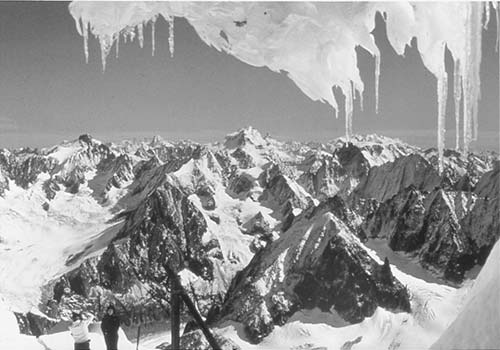
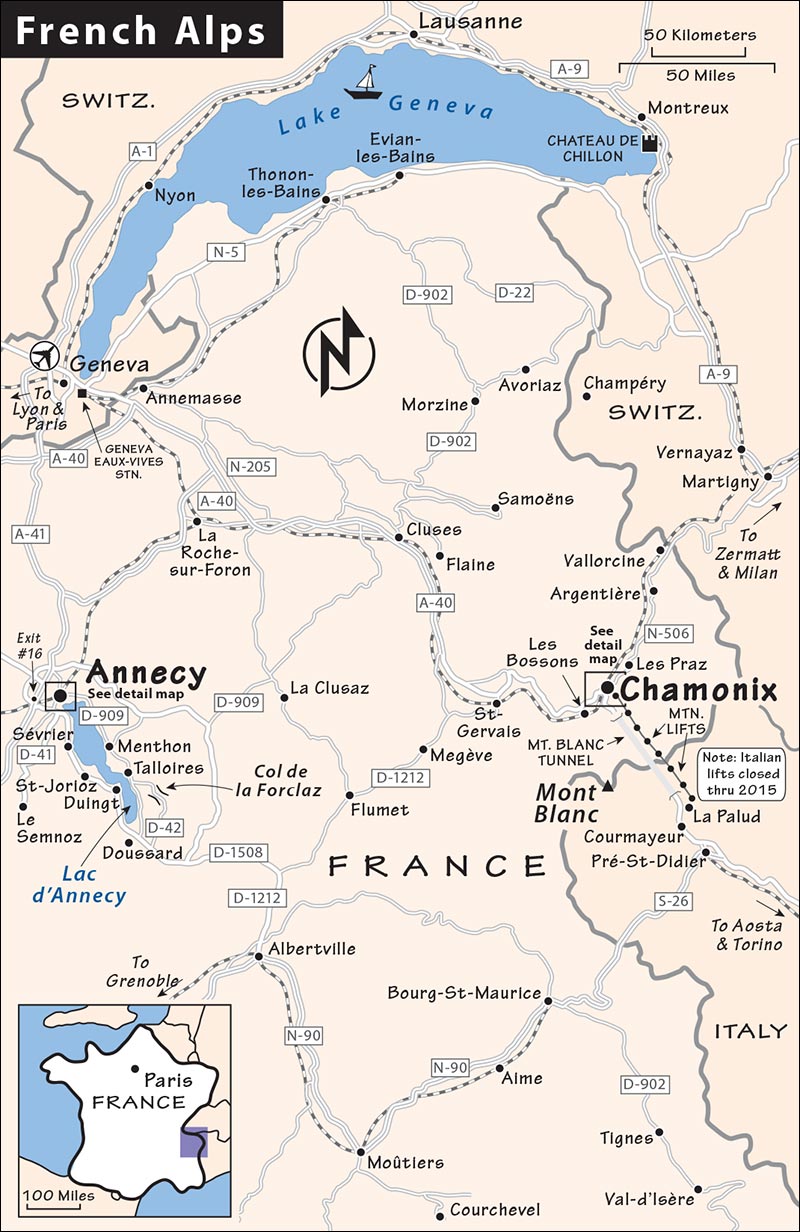
The Alps have twin peaks: the summer and winter seasons, when hotels and trails or slopes are slammed. June and November are dead quiet in Chamonix (many hotels and restaurants close) as locals recover from one high season and prepare for the next.
Annecy and Chamonix are well-connected by trains. Buses run from Chamonix to nearby villages, and the Aiguille du Midi lift takes travelers from Chamonix to Italy over Europe’s most scenic border crossing. If you have a car, autoroutes make the going easy, and scenic drives near Annecy allow you to savor remarkable views.
Entering Switzerland by Car: Drivers passing through Switzerland need a “vignette” decal to use Swiss autoroutes (about €34, valid one calendar year)—even if only to reach Geneva’s airport from bordering France (skipping the autoroute via local roads through Geneva is possible but a headache). You can buy Swiss vignettes in Annecy (ask at the TI) or on the autoroute at the border crossing.
Savoie cuisine is mountain-hearty. Its Swiss-similar specialties include fondue savoyarde (melted Beaufort and Comté cheeses and local white wine, sometimes with a dash of Cognac), raclette (chunks of semi-melted cheese served with potatoes, pickles, sausage, and bread), tartiflettes (hearty scalloped potatoes with melted cheese), poulet de Bresse (the best chicken in France), Morteau (smoked pork sausage), gratin savoyard (a potato dish with cream, cheese, and garlic), and fresh fish. Local cheeses are Morbier (look for a charcoal streak down the middle), Comté (like Gruyère), Beaufort (aged for two years, hard and strong), Reblochon (mild and creamy), and Tomme de Savoie (mild and semi-hard). Evian water comes from Savoie, as does Chartreuse liqueur. Apremont and Crépy are two of the area’s surprisingly good white wines. The local beer, Baton de Feu, is more robust than other French beers.
Restaurants serve only during lunch (11:30-14:00) and dinner (19:00-21:00, later in bigger cities and resorts like Chamonix); some cafés serve food throughout the day.
There’s something for everyone in this lakefront city that knows how to be popular: mountain views, romantic canals, a hovering château, and swimming in—or boating on, or biking around—the translucent lake. Sophisticated yet outdoors-oriented and bike-crazy, Annecy (ahn-see) is France’s answer to Switzerland’s Luzern, and, though you may not have glaciers knocking at your door as in nearby Chamonix, the distant peaks paint a darn pretty picture with Annecy’s lakefront setting. Annecy has a few museums, but none worth your time: You’re here for the stunning setting and outdoor activities. During the winter holidays, Christmas markets and festive decorations animate the city. Annecy is a joy before noon in any season, but high-season weekend afternoons will try your patience. Spend your mornings in the old city and afternoons around the lake.
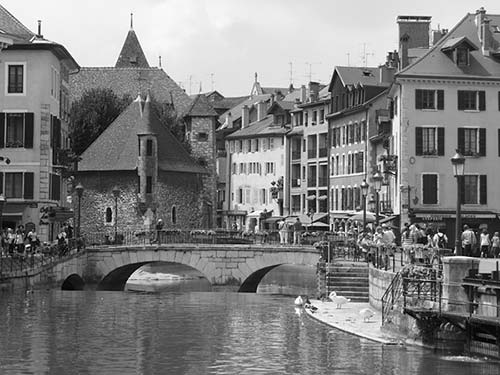
Modern Annecy (pop. 50,000) sprawls for miles, but we’re interested only in its compact old town, on the northwest corner of the lake. The old town is split by the Thiou River and bounded by the château to the south, and the TI and Rue Royale to the north.
The TI is a few blocks from the old town, across from the big grass field, inside the Bonlieu shopping center (June-mid-Sept daily 9:00-18:30 except closed Sun 12:00-13:45; mid-Sept-June Mon-Sat 9:00-12:30 & 13:45-18:00, Sun 10:00-13:00 except closed Sun mid-Nov-March; 1 Rue Jean Jaurès, tel. 04 50 45 00 33, www.lac-annecy.com). Get a city map, the Town Walks walking-tour brochure (describes four mildly interesting walks), the map of the lake showing the bike trail, and, if you’re staying a while, the helpful Annecy Guide, with everything a traveler needs to know. Ask about walking tours in English (€6.50, July-Aug only, normally Tue and Fri at 16:00). You’ll also find TIs in most villages on the lake.
By Train and Bus: The stations sit side by side. To reach the old town and TI, cross the street in front of the stations, and turn left toward the pinkish Hôtel des Alpes. Turn right on Rue de la Poste, then left on Rue Royale to reach the TI and some hotels, or continue straight to more recommended hotels. There is no baggage storage in Annecy, but day-trippers who rent bikes can leave their bags at the bike-rental shop while they ride (except at Véloncey, which doesn’t offer this service; for more on bike-rental see “Helpful Hints,” below).
By Car: Annecy is a traffic mess; in high season (July-Aug), arrive early, during lunch, or late. Avoid most of the snarls by taking exit #16 from the autoroute (headed north, it’s signed Annecy-Centre; headed south, the sign reads Albertville). Avoid exit #17, the other Annecy option, which results in a long stretch of arduous surface-street driving. From exit #16, follow Annecy/Albertville signs. Upon entering Annecy, follow signs to Le Lac or Le Château depending on the location of your hotel. (Don’t follow signs for Annecy-le-Vieux.)
Refer to the map of Annecy in this chapter for parking lots. The first 30 minutes are free; after that figure €1.30 per hour (about €16/24 hours). Ask your hotel for a free overnight parking pass for the Hôtel de Ville or Bonlieu parking lots. Upon arrival, ditch your car at the first lot that is reasonably close, then get advice from your hotel for more convenient parking. Parking Ste. Claire and Parking du Château work for the hotels I list that are away from the lake. On the lake, you can park near the big boat docks at the underground Hôtel de Ville lot or at Parking La Tournette, or a block farther along at Parking Stade Nautique.
By Plane: From Geneva’s airport (GVA, www.gva.ch), Annecy is a 45-minute autoroute drive/taxi ride (Swiss vignette required; see here); it’s a 2.5-hour trip by bus and train. From Lyon’s St-Exupéry airport (LYS, www.lyonaeroports.com), allow 1.5 hours by car—all autoroute—or 2.5 hours by train.
Market Days: A thriving outdoor food market occupies much of the old town center on Tuesday, Friday, and Sunday mornings until about 12:30. The biggest market in Annecy is on Saturday, but it’s less central and geared toward locals (more clothes, fewer crafts; until 12:30, around Boulevard Taine—several blocks behind the TI).
Supermarkets: The Monoprix is at the corner of Rue du Lac and Rue Notre-Dame (Mon-Sat 8:30-19:50, closed Sun, supermarket upstairs). A smaller Franprix is on Rue de l’Annexion just off Rue Royale (Mon-Sat 8:00-20:30, Sun 9:00-19:00).
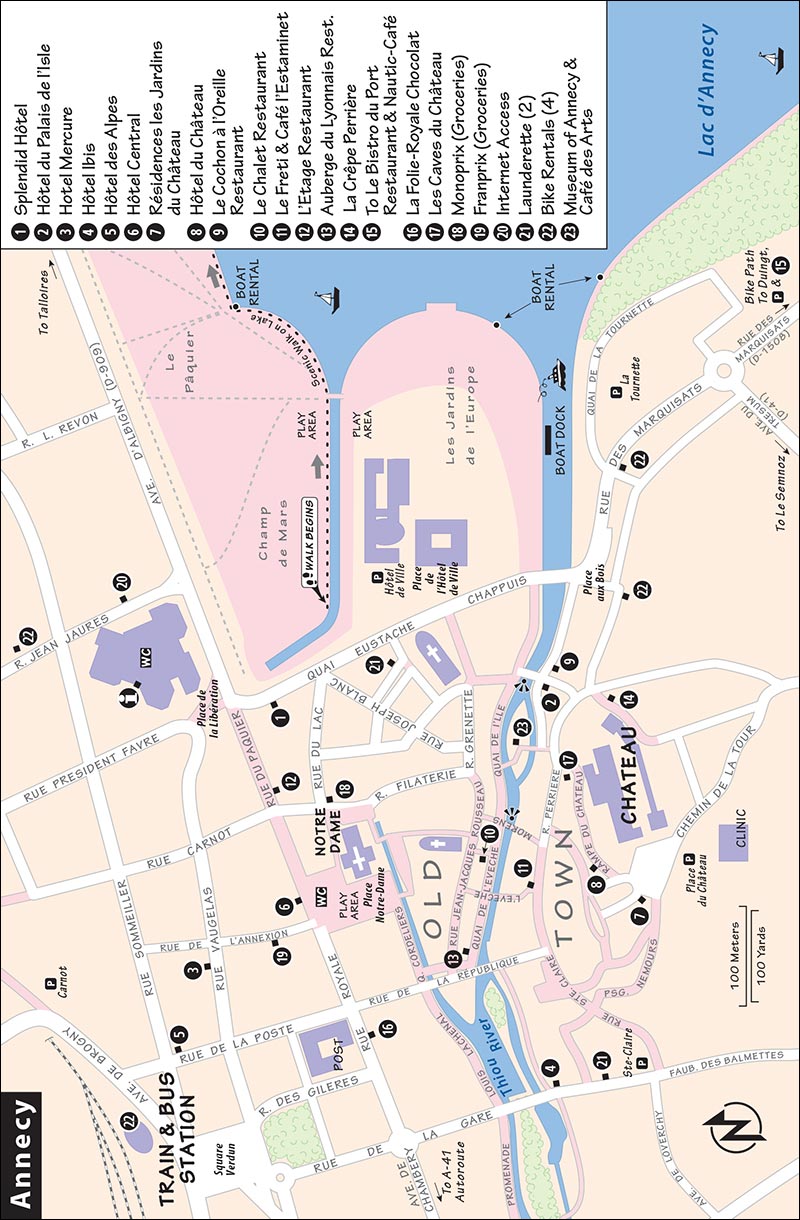
Internet Access: The TI has free Wi-Fi, and there’s an Internet café behind the TI at 4 Rue Jean Jaurès (Mon-Sat 9:30-19:00, closed Sun, tel. 04 50 33 92 60). Many Annecy cafés have Wi-Fi.
Laundry: Lav’ Confort Express launderette is at the western edge of the old town near where Rue de la Gare meets Rue Ste. Claire (6 Rue de la Gare). Le Lavoir etc., is more central, west of the Hôtel de Ville (2 Rue Camille Dunant; both daily 7:00-21:00).
Bike Rental: Several places rent electric bikes for about €45/day and standard bikes for about €20/day (leave ID as deposit, includes helmet and basket, half-day rentals and kids’ bikes also possible, hours generally daily 9:00-12:30 & 14:00-18:30). All but Véloncey can keep your bags while you ride (handy for day-trippers).
Roul’ ma Poule, near the lakefront bike path across from the lake steamers, rents rollerblades and bikes (open March-Oct, 4 Rue Marquisats, tel. 04 50 27 86 83, www.annecy-location-velo.com/en). Cyclable has two locations: behind the TI (6 Rue de Bonlieu, tel. 04 56 73 97 71) and near the lake on Place aux Bois (more choices, open May-Sept, tel. 04 50 51 51 50, www.cyclable.com). Véloncey Bikes is at the train station and requires a €250 deposit (closed Sun, tel. 04 50 51 38 90).
Car Rental: Avis is at the train station (tel. 08 20 61 16 68).
Taxi: Call 04 50 45 05 67.
Bad Weather: If it’s raining, consider a day trip to Lyon (10 trains/day, 2 hours, some by bus). The last train back to Annecy usually leaves Lyon at about 21:00, allowing a full day in the big city.
This is one of Europe’s cleanest, clearest lakes, and the water is warmer than you’d think (average summer water temperature is 72 degrees Fahrenheit).
On Your Own: To tool around the lake, rent a paddleboat (pédalos, some equipped with a slide, 2 people-about €12/30 minutes or €18/hour; some boats can handle 6 passengers) or a motorboat (hors-bord, no license needed; 2 people-about €33/30 minutes, €50/hour; each extra person-about €1, up to 7 people, several companies all have the same rates).
Lake Cruises: Compagnie des Bateaux du Lac d’Annecy offers several worthwhile lake cruises. The one-hour cruise makes no stops but has frequent departures (€14.20, 8-10/day May-Aug, 6-8/day April and Sept-mid-Oct, generally 1/day off-season, closed Jan). The two-hour cruises, called Circuit Omnibus, make stops at several villages on a clockwise loop around the lake (€18.20 for entire loop, 3-5/day late April-Sept); these are ideal for hikers and cyclists (see next two listings). The elaborate dinner and dancing cruises (€56-90) look like fun. Get schedules and prices for all boat trips at the TI or on the lake behind Hôtel de Ville (tel. 04 50 51 08 40, www.annecy-croisieres.com).
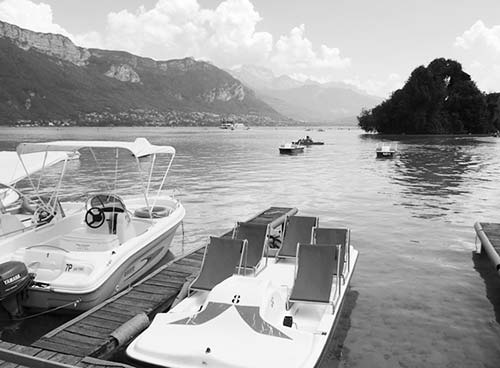
Lakeside paths and short, steep hikes up hillsides offer rewarding views, even with clouds. Here are a few ideas.
Old Town: Most of the old city is wonderfully traffic-free. The river, canals, and arcaded streets are made for ambling. The TI’s Town Walks brochure describes Annecy with basic historical information. Get lost—surrender to the luscious ice-cream shops and waterfront cafés.
Annecy’s Waterfront: Stroll the bike/walking path in either direction for lake and mountain views. The best views are found walking toward Annecy-le-Vieux (with the lake on your right). Join the festival of walkers on this popular section that passes grassy beaches and views all the way down the lake.
Duingt: The quiet village of Duingt is a 20-30-minute drive from Annecy; it’s also reachable by boat or bike (see “Biking,” next page, for a route). It has a short, steep, and beautiful trail leading up to glorious lake views. Park behind Duingt’s church, walk along the asphalt lane past the little TI and the old rail tunnel (now the bike path), and find the ramp leading up in 100 yards. Follow signs to Grotte N-D du Lac, passing the Stations of the Cross. At the end of the paved walkway (great views with benches), a steep dirt trail continues up for even better vistas (some rocky, uneven sections).
If you arrive by boat, from the dock, walk with the lake on your right into the village; find the church, and then follow the directions given above.
Talloires: From this upscale and charming village (allow 30 minutes from Annecy by car), you can hike (and I mean hike) up to jaw-dropping views over the village and the Golf de Talloires. From here, you can either double back down or continue on the Roc de Chère dirt trail to the village of Menthon-St-Bernard, where you can catch a boat back to Annecy (allow two hours from Talloires to Menthon-St-Bernard). To find the Roc de Chère trail, leave Talloires along the main road (D-909) with the lake on your left (narrow sidewalk available); after the curve, find the short staircase leading left into the trees. The trail climbs for 20 extremely steep minutes up a rocky path with some very uneven footing. You’ll pass a map of the trails that crisscross the Roc de Chère and come to benches with views. Follow Liaison Menthon-St-Bernard signs to continue to that village. You can reverse this route, but locating the trail from Menthon-St-Bernard’s boat dock takes patience: Turn right off the boat, walk to the big hotel/palace, turn left and walk 200 yards up the road, then take a right on a path marked Roc de Chère. This leads to a small road (turn right again), taking you up to the trail. If you need lunch in Talloires, find Café de la Place (€13-23 plats, daily, tel. 04 50 64 40 74).
Annecy was made for biking. It’s an ain’t-it-great-to-be-alive way to poke around the lake (sun or clouds) and test waterfront cafés and grassy parks. A popular bike trail runs along the southwest side of the lake (look for the green bike icon on white signs). Even a short ride on the bike path is worth the effort. Expect big crowds on weekends; wear sunglasses and bring water. Ride as far as your legs take you, break for a lakefront café, then return to Annecy (the path is best after the town of Sévrier, where it leaves the roadside). The Nautic-Café in Sévrier-Centre makes a fine lakefront drink stop. It’s next to the Le Bistro du Port, a short pedal after passing Sevrier’s vertical church (look for banners on the port).
The small village of Duingt (cafés and a bakery with good sandwiches) is seven level miles from Annecy and makes a good destination (see “Scenic Strolls and Hikes,” earlier). Steady pedalers make it in 45 minutes; smell-the-roses cyclists need at least an hour. You can ride to Duingt and take your bike on the Circuit Omnibus boat back to Annecy (€9.10, 3/day from Duingt; normally at 11:45, 15:30, and 18:00; more in summer, verify at boat dock or TI, bikes allowed).
To get to Duingt, leave Annecy on the main road toward Albertville (D-1508). Once the painted bike lane ends, you’ll see a sign for the trail (piste cyclable) on the left. Follow it to Duingt (to reach the boat dock in Duingt, exit the trail just after passing through the tunnel, coast down to the main road and turn left, then find the small, green boat-dock shelter in the park before the little castle—keep going for cafés and bakery). If you stay on the trail beyond Duingt, the path is beautiful, with views opening up to the south end of the lake. The next village with boats back to Annecy is Doussard (figure a 20-minute pedal from Duingt). This route works even better in reverse, as you don’t need to coordinate with the boat back from Duingt or Doussard: Take the Circuit Omnibus boat to Duingt or Doussard and pedal back.
Serious cyclists can make it all the way around the lake in about three to four hours (narrow roads and no bike path on most of the opposite side of the lake, with one good hill).
This serenely situated 13th-century building cuts like the prow of a ship through the heart of the Thiou River. Once a prison, it held French Resistance fighters during World War II. Today, you can still see several of the prison cells, but most of the museum is taken up with exhibits on local architecture since the war.
Cost and Hours: €3.80, €7.20 combo-ticket includes Château Museum, June-Sept Wed-Mon 10:30-18:00, Oct-May Wed-Mon 10:00-12:00 & 14:00-17:00, closed Tue year-round, free English leaflet.
The castle, built in the late 1100s by aristocrats from nearby Geneva, makes an impressive figure as it hangs above the lake in the old city. But inside, the château has little to offer. Many rooms house modern-art collections that rotate regularly, with a few rooms devoted to local folklore, anthropology, and natural history. Skip it.
Cost and Hours: €5.50, €7.20 combo-ticket includes Museum of Annecy, same hours as Museum of Annecy.
The busy roads that link villages along the lake (D-1508 on east side; D-909 on west side) deliver modest lake views for most of the way, but lead to a scenic route to Chamonix and access to fantastic view drives (described next).
Several roads off D-1508 lead to remarkable views of this gorgeous area. Go early for clearest skies, go late for sunsets, and skip it if it’s hazy. Both of the views below are worth ▲▲ in clear weather.
Le Semnoz: For majestic mountain panoramas near Annecy that include Mont Blanc, take the summer-only bus or drive up...and up...and up to Le Semnoz (about 5,000 feet). Allow about 30 minutes one-way and expect lots of bicycles on weekends. To drive, follow D-41 from near the lake (see map on here). After leaving the city, you’ll pass through Annecy’s forest and climb past tree level to grandiose views over the high Alps, featuring Monsieur Blanc. Just before the top, you’ll pass a great summer luge (Luge d’Eté, about €4/ride in summer, less in other months and with 5 or more rides, July-Aug daily, May-June and Sept-Oct Wed, Sat-Sun, and holidays). Carry on, climbing above the luge area, pass the hotel, and park when you see the chalet-café Le Courant d’Ere (fun place for a drink, snacks, or a meal; open daily for lunch, tel. 04 50 01 23 17). Climb to the chairlift station above the café for a magnificent panorama in all directions. You can also take a bus to this viewpoint. Ligne d’Eté buses to Le Semnoz leave from the Annecy train station (€6 round-trip, 6/day, daily July-Aug, Sat-Sun only in June, none Sept-May, 40 minutes, stops at the luge, details at TI and www.sibra.fr/ligne-dete).
Col de la Forclaz: For drop-dead gorgeous views that take in the entire lake, drive 18 miles from Annecy (allow 45 minutes one-way) to Col de la Forclaz. Start by taking D-1508 south toward Albertville. Three kilometers (about one mile) after leaving the lake at Doussard, turn left on D-42 (signed Col de la Forclaz), then wind your way up a narrow lane for five miles past lovely scenery to the Col de la Forclaz (3,600 feet). Look out for cyclists on this climb. At the top, you’ll find a sensational viewpoint, cafés and restaurants, and paragliders galore. Several outfits offer a chance to jump off a cliff and sail over the lake, including the appropriately named Adrenaline Parapente (www.annecy-parapente.com). This trip ties in well with the scenic route to Chamonix via D-1508; it also works as a loop back to Annecy (follow D-42 down to Menthon-St-Bernard from the Col de la Forclaz).
Annecy is popular, particularly on weekends and during the summer. Hotel rates drop from about mid-October through late April and increase in summer. Most hotels can help you find free overnight parking (in lots, usually after 19:00 until 9:00 in the morning). Unless otherwise noted, these hotels do not have elevators. For more hotel listings, try Annecy’s TI website: www.lac-annecy.com.
This part of town is pedestrian-friendly and comes with some noise.
$$$ Splendid Hôtel*** decorates Annecy’s busy, parkfront street and makes an impression with its grand, American-style facade. Inside, rooms are well-appointed and public spaces are comfy (Db-€137—but a few at €123, suites-€161, extra person-€16, breakfast-€14, air-con, elevator, big beds, bar, terrace, 4 Quai Eustache Chappuis, tel. 04 50 45 20 00, www.splendidhotel.fr, info@splendidhotel.fr).
$$$ Hôtel du Palais de l’Isle*** offers a romantic canalside location in the thick of the old town and 34 contemporary rooms—several with canal or rooftop views and little fridges. The wine bar/TV room doubles as a nice lounge (true Sb-€86, Db-€127-148, grand suites-€238-298, breakfast-€14, air-con, elevator, 13 Rue Perrière, tel. 04 50 45 86 87, www.palaisannecy.com, contact@palaisannecy.com).
$$$ Hotel Mercure****, well-located near the train station, has predictable comfort (Db-€180-215, 26 Rue Vaugelas, tel. 04 50 45 59 80 www.mercure.com, H2812@accor.com).
$$$ Hôtel Ibis*** is a solid option, with updated, well-configured rooms (all with queen-size beds), a canalside lounge, and easy underground parking. It’s well-situated on the edge of the old town, a few blocks from the train station (Sb/Db-€110-142, check website for best deals, extra bed-€10, buffet breakfast-€10, air-con, elevator, 12 Rue de la Gare, tel. 04 50 45 43 21, www.ibishotel.com, h0538@accor.com).
$$ Hôtel des Alpes**, a good value, has 32 comfortable and attractive rooms at a busy intersection just across from the train station. Rooms on the courtyard are quieter, but those on the street have effective double-pane windows (Sb-€65, Db-€70-90, Tb-€90-115, Qb-€108-140, breakfast-€8.50, 12 Rue de la Poste, tel. 04 50 45 04 56, www.hotelannecy.com, info@hotelannecy.com).
$ Hôtel Central is just that and more. Run by your Annecy mother, Corinne, this modest, homey, and hyper-decorated place makes a fun stay. Every well-maintained room has a different theme, from Sevilla to India. It’s located in the rear of a modest, ivy-covered courtyard (Db-€60-70, Tb-€90, Qb-€110, breakfast-€6, 6 bis Rue Royale, tel. 04 50 45 05 37, www.hotelcentralannecy.com, hotelcentralannecy@orange.fr).
These places are in a quiet area, a steep five-minute walk up from the old town on Rampe du Château.
$$ Résidences les Jardins du Château is an urban refuge above the fray near the château entry. It has a small garden and a view terrace, along with eight simple but comfy rooms—there are no phones or TVs, and most rooms come with kitchenettes (Db-€70-120 depending on room size and season, good family rooms, cash only, no refunds, 1 Place du Château, mobile 06 67 91 94 23, www.jardinduchateau.sitew.com, rent74@free.fr).
$$ Hôtel du Château**, an unpretentious place run by unpretentious Romain and Amélie, sits barely below the château. It comes with a view terrace and 16 simple, deep yellow, spotless rooms—about half have views. It’s first-come, first-get for the precious few free parking spots (small Db-€78, standard Db-€88, Tb-€98, Qb-€114, continental breakfast-€9, rental bikes available, 16 Rampe du Château, tel. 04 50 45 27 66, www.annecy-hotel.com, hotelduchateau@noos.fr).
(See “Annecy” map, here.)
Although the touristy old city is well-stocked with forgettable restaurants, I’ve found a few worthy places. And though you’ll pay more to eat with views of the river or canal, the experience is uniquely Annecy. The ubiquitous and sumptuous gelati shops remind you how close Italy is. If it’s sunny, assemble a gourmet picnic at the arcaded stores and dine lakeside.
Le Cochon à l’Oreille (“The Pig’s Ear”) is a meat lover’s nirvana. Just off the Thiou canal, it welcomes you with a leafy courtyard and a raucous, higgledy-piggledy interior. Amicable owners “Fred” and Jean speak enough English (and fluent pig) and are serious about their cooking (ask to see their pig collection). The accent is on fresh products and meat dishes (particularly ham and pork), though fish options are available. Melted cheese is not their thing (€20 two-course menu changes weekly, closed Mon, Quai du Perrière, tel. 04 50 45 92 51).
Le Chalet, ideally located along the river, features French and Italian classics (at riverside prices). Sit in the cozy, wood-paneled interior or choose canalfront outdoor seating (€29-52 menus, closed Sun, Quai de l’Evêché, tel. 04 50 51 82 55).
Le Freti, is a reliable restaurant for local cuisine at fair prices. It’s the place to go for good fondue, raclette, or anything with cheese. Each booth comes with its own outlet for melting raclette (€15 fondue, €8 salads and onion soup, cheap wine, air-con, open daily for dinner, lunch weekends only, walk through door at 12 Rue Ste. Claire and go upstairs, tel. 04 50 51 29 52).
If Le Freti sounds too cheesy, go next door to Café l’Estaminet for some pub grub. You’ll get a cozy interior with a few waterside tables on the back terrace, a fun bar area, and salads, omelets, pasta, mussels, fries, and more for fair prices (daily in summer, closed Sun evening and Mon off-season, 8 Rue Ste. Claire, tel. 04 50 45 88 83).
L’Etage is a good choice if you can’t decide what you want. Regional specialties and a good range of standard brasserie fare are served at respectable prices. Dine along the pedestrian street terrace or upstairs under wood beams around a big fireplace (€16 fondue and raclette, €19 three-course menus, daily, 13 Rue du Paquier, tel. 04 50 51 03 28).
Auberge du Lyonnais is a classy, well-respected riverfront eatery that specializes in seafood (indoor and outdoor seating). The outgoing owners love Americans; ask Dominique about his many trips to the States, and about his Ford pickup (€27-40 menus, cheaper on weeknights, daily except closed Wed off-season, 9 Rue de la République, tel. 04 50 51 26 10).
La Crêpe Perrière, a good budget option in a quiet spot, has €8-10 crêpes and salads, a small terrace, and interior seating (daily, below the château at 3 Côte Perrière, tel. 04 50 51 76 36).
Lakefront Dining: Many cafés and restaurants ring Annecy’s postcard-perfect lake. If you have a car and want views, prowl the many waterfront villages. Le Bistro du Port, a nautical place five minutes from Annecy by car, is beautifully situated on the boat dock at the southern end of Sévrier-Centre (€15 lunch menu, €36 dinner menu, €25 plats, daily, Port de Sévrier, turn off D-1508 at the McDonald’s, tel. 04 50 52 45 00).
Dessert: Wherever you eat, don’t miss an ice-cream-licking stroll along the lake after dark. But if it’s chocolate you crave, head for La Folie-Royale (closed all day Sun and Mon morning, 13 Rue Royale, tel. 04 50 52 28 58).
Drinks: Start or end your evening at one of these local and different-as-night-and-day places. At the cozy wine bar, Les Caves du Château, you’ll escape the crowds by heading just 20 steps up the Rampe du Château from busy Rue Ste. Claire. They offer a huge choice of wines by the glass from throughout France and serve appetizers (daily except closed Mon Sept-June, 6 Rampe du Château, tel. 09 51 17 29 98). Café des Arts is Annecy’s most atmospheric café, marooned on the island at the Palais de l’Ile. With good prices, it attracts a mix of local hipsters and the odd tourist (daily from early to late, 4 Passage de l’Isle, tel. 04 50 51 56 40).
From Annecy by Train to: Chamonix (11/day, 2.5 hours, change in St-Gervais), Lyon (10/day, 2 hours, some by bus), Beaune (7/day, 4-6 hours, change in Lyon), Nice (4/day, 7 hours, start with bus or train to Lyon, more with 2-3 changes), Paris’ Gare de Lyon (hourly, 4 hours, many with change in Lyon), Geneva (about hourly, 2 hours; bus-and-train options available from Geneva’s airport in 2.5 hours).
Showered with snow-dipped peaks, bullied by menacing glaciers, and blanketed with hiking trails, the resort of Chamonix (shah-moh-nee) is France’s best base for alpine exploration. Officially called Chamonix-Mont Blanc, it’s the largest of five villages at the base of Mont Blanc, with about 10,000 residents and nearly as many mountain lifts (well, almost). Chamonix’s purpose in life has always been to dazzle visitors with some of Europe’s top alpine thrills. But you’ll also learn a thing or two about glaciers and get an insight into the wild world of mountain climbing. Chamonix is a busy place from early July through late August and during winter holidays, but it’s plenty peaceful at other times. Chamonix’s sister city is Aspen, Colorado. Perfect.
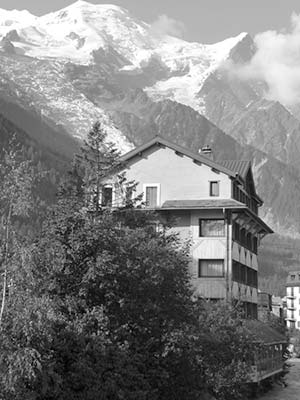
Summers bring huge crowds and long lift lines. You won’t regret planning your trip to avoid the summer school break (vacances scolaires), early July to late August. Ride the lifts early (crowds and clouds roll in later in the morning) and save your afternoons for lower altitudes.
If you have one sunny day, spend it this way: Start with the Aiguille du Midi lift (go early, reservations possible and recommended July-Aug), take it all the way to Helbronner (linger around the rock needle longer if you can’t get to Helbronner), double back to Plan de l’Aiguille, hike to Montenvers and its Mer de Glace (only with good shoes and snow level permitting), explore there, then take the train down to Chamonix. End your day with a well-deserved drink at a view café in town. If the weather disappoints or the snow line’s too low, hike the Petit Balcon Sud or Arve River trails.
Eternally white Mont Blanc is Chamonix’s southeastern limit; the Aiguilles Rouges mountains form the northwestern border and the frothy Arve River splits linear Chamonix in two. The thriving pedestrian zone, above and west of the river along Rues du Docteur Paccard and Joseph Vallot, forms Chamonix’s core. The TI is just above the pedestrian zone, and the train station is two long blocks below and east of the river. To get your mountain bearings, head to the TI and find the big photo in front. With Switzerland and Italy as next-door neighbors, this town has always drawn an international crowd. Today about half of its foreign visitors are British—many have stayed and found jobs in hotels and restaurants.
Visit the TI to prepare your attack. Get the weather forecast, pick up the free town and valley map and the “panorama” map of all the valley lifts, and maybe the €4.50 hiking map called Carte des Sentiers (see “Chamonix Area Hikes” on here). Ask about snow levels, hours of lifts and trains (critical), the Multipass for lifts, which is described later under “Getting Around (and Up and Down) the Valley,” biking information, and help with hotel reservations. Their helpful website has updated sightseeing info, weather forecasts, and more (daily July-Aug and mid-Dec-mid-April 9:00-19:00, off-season generally 9:00-12:30 & 14:00-18:00 except Oct-Nov closed Sun; tel. 04 50 53 00 24, www.chamonix.com, info@chamonix.com).
Pull up a beachy sling chair outside the TI and plan your hike, or check your email using their 24-hour Wi-Fi (free access outside, plus small cubicles inside to hole up in).
By Train: Walk straight out of the station (no baggage check) and up Avenue Michel Croz (see the map on here). In three blocks, you’ll reach the town center; turn left at the big clock, then right for the TI.
By Bus: The long-distance bus station is south of the town center (234 Avenue de Courmayeur, behind the bowling alley). It’s a 20-minute walk to the town center (see map on here). Walk up Avenue de Courmayeur, cross the river, turn right on Avenue Ravanel le Rouge, then keep straight. Or take the free shuttle bus called Le Mulet, see here.
By Car: For many of my recommended hotels and the TI, take the Chamonix Nord turnoff—coming from Annecy and Geneva, it’s the second exit after you pass under the Aiguille du Midi cable car—and follow signs to Centre-Ville. Take the exit before the Aiguille du Midi lift station for hotels south of the TI. Most parking is metered and well-signed; your hotel can direct you to free parking. From mid-July to late August, traffic is a mess in Chamonix, and finding parking is messier—plan ahead or arrive before 10:00 to get a spot.
The Mont Blanc tunnel (7.2 miles long, about a 12-minute drive) allows quick access between Chamonix and Italy (one-way-€44, round-trip-€55 with return valid for 1 week, www.tunnelmb.com).
By Plane: The nearest international airports are in Lyon (St-Exupéry airport, airport code: LYS, www.lyonaeroports.com; linked by 6 trains/day, 4 hours; 3 hours by car) and Geneva, Switzerland (Genève airport, airport code: GVA, www.gva.ch; hourly trains, 3.5-5 hours with two changes; 2 hours by car; best by airport shuttle van or bus—see “Chamonix Connections” on here).
Crowd-Beating Tips: In high season, take the first lift to beat the crowds and afternoon clouds. Have a view breakfast at le top.
Plan Ahead: Bright snow abounds up high, so bring sunglasses. Be sure your camera has enough battery power. For Chamonix’s weather, check at your hotel, the TI, or online at www.chamonix.com or www.chamonix-meteo.com. For current lift information and to book the Aiguille du Midi lift, head to the Compagnie du Mont Blanc website (www.compagniedumontblanc.com).
Open-Air Market: Chamonix’s market is held Saturdays and fills big Place Mont Blanc (until about 13:00).
Supermarkets: Little Casino markets are omnipresent in Chamonix. The Super-U is central and big (next to the recommended Hôtel les Crêtes Blanches on Rue Joseph Vallot). Supplement your run-of-the-mill groceries with gourmet local specialties from Le Refuge Payot (two locations: 166 Rue Joseph Vallot and 255 Rue du Docteur Paccard).
Inexpensive Mountain Gear: The best deals on sunglasses, lightweight gloves, daypacks, and the like are at Technique Extrême (daily 9:00-19:00, closed for lunch off-season, 200 Avenue de l’Aiguille du Midi).
Internet Access: The TI has free Wi-Fi and a good list of Internet cafés.
English Books: Small collections are kept at Librarie Landru (open daily, 74 Rue Joseph Vallot) and at Maison de la Presse (daily, 93 Rue du Docteur Paccard).
Laundry: A self-service laverie is one block up from the Aiguille du Midi lift at 174 Avenue de l’Aiguille du Midi (daily 8:00-22:00, instructions in English).
Taxis: There’s usually one at the train station. If not, try Alp Taxi (mobile 06 81 78 79 51, www.alp-taxi.com) or Taxi Michel Buton (mobile 06 07 19 70 36, www.taxi-buton-chamonix.com).
Car Rental: Europcar, the only game in town, is across from the train station (Mon-Sat 8:30-12:00 & 14:00-18:00, closed Sun, 36 Place de la Gare, tel. 04 50 53 63 40, mobile 06 85 40 07 72).
Lifts and cogwheel trains are named for their highest destination (for example, Aiguille du Midi, Montenvers, and Le Brévent). More details on individual lifts are described under “Sights in Chamonix,” later. You can find current lift information and book the Aiguille du Midi lift on the Compagnie du Mont Blanc website, though it’s a little clunky to use (www.compagniedumontblanc.com).
By Lift: Gondolas (téléphériques) climb mountains all along the valley, but the best one—Aiguille du Midi—leaves from Chamonix. Though sightseeing is optimal from the Aiguille du Midi gondola, there are more hiking options from the Le Brévent and La Flégère gondolas.
The lift to Aiguille du Midi is open summer and winter (usually closed Nov-mid-Dec). The télécabines on the Panoramic Mont Blanc lift to Helbronner (atop the Italian border) run only from about late June to early September, and even then only in good weather. The lift called Skyway Monte Bianco, on the Italian side of the mountain, runs from Helbronner down to Pontal d’Entrèves (with a stop at Pavillon du Mont Fréty) and rotates 360 degrees for panoramic views en route.
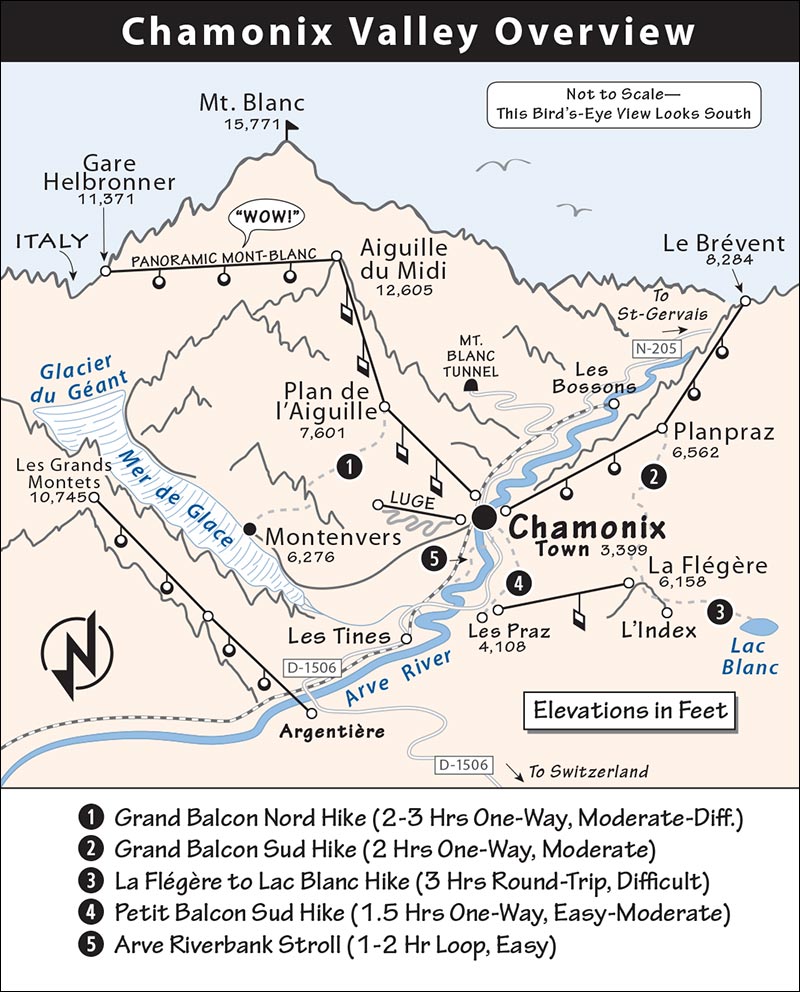
Other area lifts are generally open from January to mid-April and from mid-June to late September. Because maintenance closures can occur anytime, verify schedules for all lifts at the TI.
The Multipass ticket option saves time and money for most, particularly if you’re spending two or more days in the Chamonix valley. It allows unlimited access to all the lifts and trains (except the Helbronner gondola to Italy), and includes all reservation fees (both Aiguille du Midi and Montenvers). You also get discounts for various activities in Chamonix, such as the Parc de Loisirs des Planards.
Best of all, it lets you bypass lift-ticket lines after your first purchase. Your pass is a smart card, valid all day, that allows you to scan your way to the top and to ride lifts you’d otherwise skip. You could hop on a lift just to have a drink from a view café at the top (€60/1 day, €73/2 days, €84/3 days, €98/4 days, €109/5 days, available for up to 15 days; days are consecutive, though you can buy a more expensive pass for nonconsecutive days; kids ages 4-15—and kids over 64—pay about 15 percent less for two-day and longer passes, kids under 4 may not be allowed). The one-day pass is a good value if you plan to do the round-trip lift from Chamonix to Aiguille du Midi plus the round-trip train from Chamonix to Montenvers (and not hike between the two). Families benefit from reduced fares. The pass is sold online (www.compagniedumontblanc.com), at participating lift stations, and at some hotels for no added cost. Passes are nonrefundable unless purchased through a hotel.
By Foot: See “Chamonix Area Hikes” on here.
By Bike: The peaceful river valley trail is ideal for bikes (and pedestrians). The TI has a brochure showing bike-rental shops and the best biking routes.
By Bus or Train: One road and one scenic rail line lace together the valley’s towns and lifts. To help reduce traffic and pollution, your hotel will give you a free Chamonix Guest Card good for free travel during your stay. The cards are valid on all Chamonix-area buses (except the night bus) and the scenic valley train between Servoz and Vallorcine, and also give small discounts on a handful of area sights. This is a great value for those with time to explore the valley.
Local buses #1, #2, and #21 run to valley villages (1-2/hour, #21 runs only mid-June-early September, details in English at www.chamonix.montblancbus.com/en). Changes to some routes are possible for 2016—get the latest on the website or at the TI. The main stops are 200 yards to the right when you leave the TI (past Hôtel Mont Blanc—look for the bus shelters) and on Rue Joseph Vallot where it crosses Avenue du Mont Blanc. Direction “Le Tour” on bus #1, “Les Praz/Flégère” on bus #2, or “Col des Montets” on bus #21 will take you toward Les Praz (for Hikes #2 and #3) and Switzerland (see map on here).
Le Mulet minibuses circulate around Chamonix village and are lifesavers for pooped hikers; they’re especially handy to or from the Aiguille du Midi lift, which is a 15-minute walk from many hotels (free, every 15 minutes, mid-June-early-Sept and mid-Dec-mid-April daily 7:45-19:00; off-season runs every 30 minutes only on weekends).
The train ride toward Martigny in Switzerland is gorgeous, and villages such as Les Praz and Tines (10 minutes by bus) offer quiet escapes from busy Chamonix.
MOUNTAIN LIFTS, GONDOLAS, AND TRAINS
Map: Alpine Crossing from France to Italy
▲▲▲Gondola Lifts to Le Brévent and La Flégère
▲▲Hike #1 Plan de l’Aiguille to Montenvers-Mer de Glace (Grand Balcon Nord)
▲▲Hike #2 La Flégère to Planpraz (Grand Balcon Sud)
▲▲Hike #3 La Flégère to Lac Blanc
▲Hike #4 Petit Balcon Sud to Chalet de la Floria and Les Praz
Hike #5 Arve Riverbank Stroll and Paragliding Landing Field
Espace Tairraz: Crystal Museum and Mountaineering Center (Musée des Cristaux and Espace Alpinisme)
The Aiguille du Midi (ay-gwee doo mee-dee) is easily the valley’s (and, arguably, Europe’s) most spectacular and popular lift. If the weather’s clear, the price doesn’t matter. Take an early lift and have breakfast above 12,000 feet.
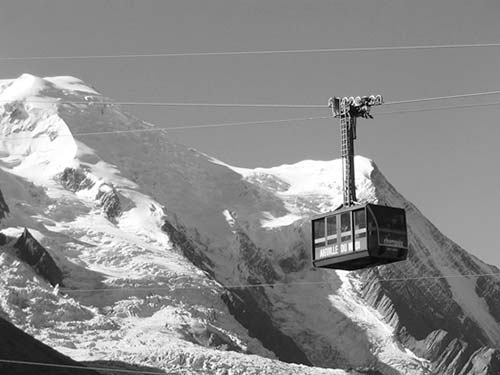
Cost: From Chamonix to Plan de l’Aiguille—round-trip-€31 (one-way-€16); Aiguille du Midi—round-trip-€57 (one-way-€47, not including parachute); the Panoramic Mont Blanc télécabine to Helbronner—round-trip-€84. If you are planning to stop at Plan de l’Aiguille on the way back down and hike to Montenvers, ask about a spécial randonée ticket for about €49. Tickets for the télécabines from Aiguille du Midi to Helbronner are sold at both base and summit lift stations with no difference in price (round-trip-€30). It’s €45 to drop into Italy (sold at Helbronner). Oui and si, you can bring your luggage—but pack light.
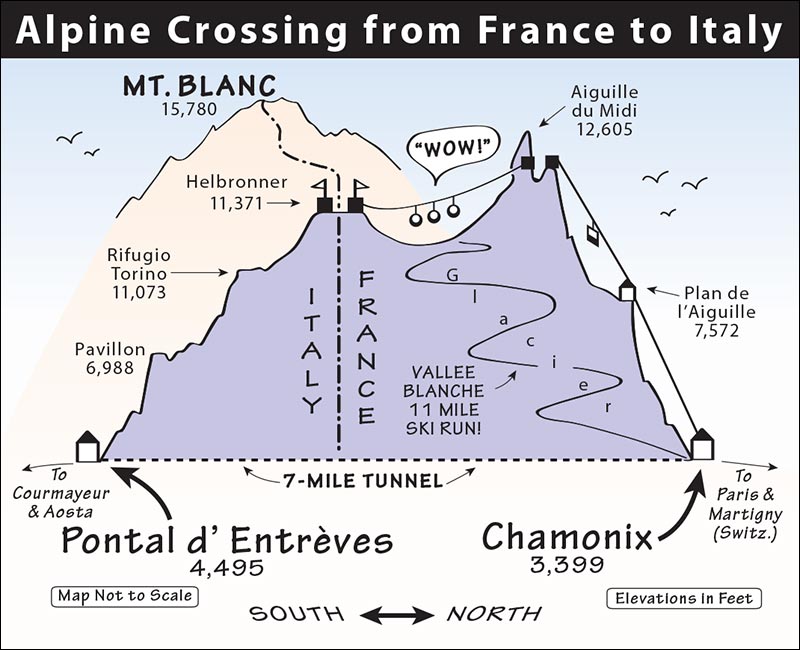
Discounts: The prices listed above are for ages 16 and over; kids ages 4-15 cost about 15 percent less (family rates for 2 adults and 2 children ages 15 and under are also available).
Hours: Lifts are weather- and crowd-dependent, but generally run daily July-Aug 6:30 or 7:00-16:30 or 17:00, late May-June and Sept 7:30 or 8:00-16:30 or 17:00, and Oct-late May 8:00-15:30. Gondolas run every 10 minutes during busy times; the last return from Aiguille du Midi is generally one hour after the last ascent. The last télécabine departure to Helbronner Point is about 14:00-15:00, and the last train down from Montenvers (for hikers) is about 17:00-18:00.
Crowd-Beating Strategies: To beat the hordes and clouds, ride the Aiguille du Midi lift (up and down) as early as you can. To beat major delays in summer, leave no later than 7:00 or reserve ahead (first lift departs at 6:30 or 7:00, verify in advance). If the weather has been bad and turns good, expect big crowds in any season. If it’s clear, don’t dillydally. If you arrive after 9:00 in summer your ticket will likely include an assigned gondola time (usually within 30 minutes).
From July to August, smart travelers reserve the Aiguille du Midi lift in advance (€2 fee). You can reserve at the information booth next to the lift (open mid-June-mid-Sept), online at www.compagniedumontblanc.com, or by phone (year-round, tel. 04 50 53 22 75, automated reservations in English). Reservations are taken from one to seven days in advance (not same day); pick tickets up at the lift station at least 20 minutes before departure (the information booth at the Aiguille du Midi lift tells you which window to use for priority access). Reservations are free with a Multipass (see here) and are not possible for the télécabines to Helbronner.
Time to Allow: Chamonix to Aiguille du Midi—20 minutes one-way, 2 hours round-trip, 3 hours in peak season; Chamonix to Helbronner—1.5 hours one-way, 3-4 hours round-trip, longer in peak season. On busy days, minimize delays by making a reservation for your return lift time upon arrival at the top.
Visiting the Aiguille du Midi: Pile into the téléphérique (gondola) and soar to the tip of a rock needle 12,600 feet above sea level (you’ll be packed into the gondola like sardines; take off your daypack to allow more room). Get a spot on the right side for glacier views. Chamonix shrinks as trees fly by, soon replaced by whizzing rocks, ice, and snow. Change gondolas at Plan de l’Aiguille to reach the top. No matter how sunny it is, it’s cold and the air is thin. People are giddy with delight (those prone to altitude sickness or agoraphobia are less so). Fun things can happen at Aiguille du Midi if you’re not too winded to join the locals in the halfway-to-heaven tango.
From the top of the lift station, you have several options. Follow ascenseur/pas dans le vide signs through a tunnel, then ride the free elevator through the rock to the summit of this pinnacle. Missing the elevator is a kind of Alpus-Interruptus I’d rather not experience. The Alps spread out before you. Find the orientation posters to identify key peaks. If it’s really clear, you can see the bent little Matterhorn—the tall, shady pyramid listed in French on the observation table as “Cervin—4,505 meters” (14,775 feet). And looming on the other side is Mont Blanc, the Alps’ highest point, at 4,810 meters (15,780 feet). Mont Blanc and the Matterhorn were first connected by intrepid backcountry skiers in 1903 via La Route Haute (The High Route). Today, it’s one of the most popular ski trails (not difficult from a technical point of view). Skiers cover approximately 180 kilometers (112 miles) over about eight days, sleeping in hiking huts overnight.
Use the telescopes to spot mountain climbers; more than 2,000 scale this mountain each year. A long but not technically challenging climb, it was first scaled in 1786, more than 170 years before this lift was built (are you kidding?). Find the giant’s tooth, spot the télécabines to Italy, and identify lift stations of the Aiguilles Rouges mountain range on the other side of Chamonix. That rusty tin-can needle above you serves as a communications tower. Check the temperature next to the elevator. Plan on 32 degrees Fahrenheit, even on a sunny day. Sunglasses are essential. Don’t miss the chance to step into the void (pas dans le vide) and stand on a glass platform staring down some 3,000 feet to glaciers below. Ooh la la.
Back down, explore Europe’s tallest lift station. More than 150 yards of tunnels (galeries) lead to an enclosed view room, a free and worthwhile exhibit, L’Espace Vertical, on the extreme sport of mountain climbing, a cafeteria (fair prices—have lunch or coffee with a view), a restaurant (not such fair prices), WCs, a gift shop, and an icicle-covered gateway to the glacial world. A right turn out of the elevator leads you through a tunnel to the Mont Blanc Cosmiques Terrace, a small deck with more views. Interview a mountain climber (many are British) to get an insight into their sport.
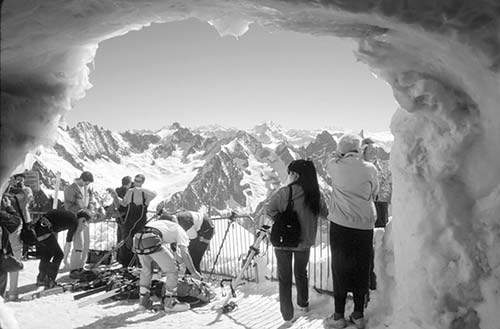
Go back through the tunnel to the main building, where gondolas return to Chamonix, and climb metal stairs to more view terraces, WCs, the cafeteria, and gift shop. Inside you’ll see a small exhibit describing the 1950s construction of the lift station and the gondola line (the first cable was destroyed during construction by an avalanche). The photos are fascinating.
Follow Vallée Blanche signs to a drippy “ice tunnel” where skiers and mountain climbers make their exit. The views are sensational; merely observing is exhilarating. Peek down the icy cliff and ponder the value of an ice ax. Skiers make the 11-mile run to the Mer de Glace (described later) in about half a day (in winter they can ski 13 miles all the way back to the valley at Argentière). The Access Belvedere walkway leads to bird’s-eye views of the télécabines to Helbronner and to more amazing mountain views.
For your private glacial dream world, get into the little red télécabine (called Panoramic Mont Blanc) and sail south to Helbronner Point, the Italian border station (typically open late June-early Sept). This line stretches three miles with no solid pylon. (It’s propped by a “suspended pylon,” a line stretched between two peaks 1,300 feet from the Italian end.) In a gondola for four, you’ll dangle silently for 40 minutes as you glide over glaciers and past a forest of peaks to Italy. Hang your head out the window and explore every corner of your view. From Helbronner Point, you’ll turn around and return to Aiguille du Midi, or you can descend into Italy on the Skyway Monte Bianco lift (described later, under “Day Trips near Chamonix”)—but for most there’s really no point unless you’re traveling that way.
From Aiguille du Midi, you can ride all the way back to Chamonix; or—way, way better—get off halfway down at Plan de l’Aiguille, where you’ll find a scenic café with sandwiches, drinks, cheap sunglasses, outdoor tables, and paragliders jumping off cliffs (except in July-Aug). But the best reason to get off here is to follow the wonderful trail to the Mer de Glace, then catch the train back into Chamonix (for details, see “Chamonix Area Hikes—Hike #1” on here).
Even if you don’t do the hike, take a 35-minute round-trip walk below the lift station to the ignored and peaceful Refuge-Plan de l’Aiguille for reasonable meals (good omelets, pastas, salads for €10, and mouthwatering tarts for €6, made by welcoming manager Claude—no English, no problem) and drinks inside or out (open daily May-late Oct, tel. 06 65 64 27 53). This makes an easy mini-hike for hurried travelers (or a great overnight for a steal—see “Sleeping in Chamonix,” later). The short but steep climb back up to the lift will be your exercise for the day.
Don’t hike all the way down to Chamonix from Plan de l’Aiguille or Montenvers-Mer de Glace; it’s a long, steep walk through thick forests with few views.
From Gare de Montenvers (the little station over the tracks from Chamonix’s main train station), the cute cogwheel Train du Montenvers toots you up to tiny Montenvers (mohn-tuh-vehr). Sit on the left-hand side as you go up for good views among pine trees over the valley. There you’ll see a dirty, rapidly receding glacier called the Mer de Glace (mayr duh glahs, “Sea of Ice”) and fantastic views up the white valley (Vallée Blanche) of splintered, snow-capped peaks.
Cost and Hours: Round-trip-€31, one-way-€25, family rates available, prices include gondola and ice caves entry, daily 8:30-17:00, July-Aug 8:00-18:00, last trip down at 16:30, 2-3/hour, 20 minutes, confirm times with TI or call 04 50 53 12 54.
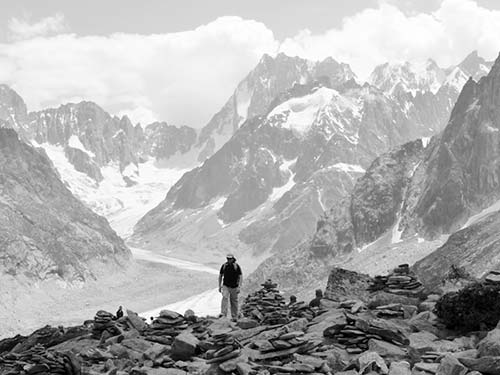
Visiting the Glacier: Find the view deck across from the train station. France’s largest glacier, at eight miles long, is impressive from above and below. The swirling glacier extends under the dirt about a half-mile downhill to the left. Imagine that it recently reached as high as the vegetation below (see the dirt cliffs—called moraines—left behind in its retreat). In 1860, this glacier stretched all the way down to the valley floor. Some say this fast-moving glacier is just doing its cyclical thing, growing and shrinking—a thousand years ago, cows grazed on grassy fields here. Al Gore thinks people are speeding up the process. Either way, it’s an in-your-face lesson about global climate change (see the “Understanding the Alps” sidebar on here).
Use an orientation table as you look up to the peaks. Aiguille du Dru’s powerful spire, at about 11,700 feet, makes an irresistible target for climbers. It was first scaled in 1860 (long before the train you took here was built) and was recently free-climbed (no ropes, belays, etc.); see the colored lines indicating different routes taken—one by an Américain. Those guys are nuts. The smooth snow field to the left of Dru’s spire (Les Grands Montets) is the top of Chamonix’s most challenging ski run, with a vertical drop of about 6,500 feet (down the opposite side). The path to the right (as you face the glacier) leads to a fine view café and a reconstruction of a crystal cave.
The glacier’s ice caves are beneath you. Take the free, small gondola down and prepare to walk about 460 steps each way. Several years ago, it was 280 steps. This glacier is beating a hasty retreat—as you walk down you’ll pass signs that bring this point home by showing the level of the glacier over the years. The ice cave, a hypnotizing shade of blue-green, is actually a long tunnel dug about 75 yards into the glacier. Informative panels describe the digging of the cave. This is also where skiers end their run from the Aiguille du Midi (you might recognize someone if you rode that lift earlier).
The Refuge-Grand Hôtel du Montenvers, a few minutes’ walk toward Chamonix from the viewing platform outside the station, offers a full-service restaurant, view tables (fair prices, limited selection), and a warm interior (you can even bunk here—see “Sleeping in Chamonix,” later). The little museum upstairs describes the history of the Montenvers train (no English but good exhibits). The hotel was built in 1880, when “tourists” arrived on foot or by mule.
The three-hour trail to Plan de l’Aiguille (see here for a description) begins across from the hotel. Walk above the two stone buildings and follow the trail as it rises just above the Mer de Glace valley (follow itinéraire conseillé signs toward Signal Plan de l’Aiguille). For terrific views, hike toward Plan de l’Aiguille—even just a short distance. The views get better fast, and the higher you climb, the better they get as the peaks of the Aiguilles Rouges come into sight behind you. Bring a picnic.
A Glaciorium lies fifty yards behind the hotel along the main walkway. It houses a small but worthwhile exhibit on glaciers of the world with dioramas, interactive displays, and terrific images that explain the life of a glacier and where they are headed (free, daily 9:30-18:00 in summer, 10:00-16:00 in winter).
Though Aiguille du Midi gives a more spectacular ride, the Le Brévent and La Flégère lifts (téléphériques) offer worthwhile hiking and viewing options, with unobstructed panoramas across to the Mont Blanc range and fewer crowds. The Le Brévent (luh bray-vahn) lift is in Chamonix; the La Flégère (lah flay-zhair) lift is in nearby Les Praz (lay prah). The lifts are connected by a scenic hike, or by bus along the valley floor (free with Chamonix Guest Card, see Hike #2 in the next section); both have sensational view cafés. Both lifts are closed from late April to mid-June and again by mid-September (reopening when ski season starts, usually in Dec).
Le Brévent: This lift is a steep 10-minute walk up the road above Chamonix’s TI. It takes two lifts to reach Le Brévent’s top. The first lift to Planpraz, with automated eight-person télécabines, runs every minute. Sit backward and watch Chamonix shrink below (round-trip to Planpraz-€17, one-way-€14, pleasant restaurant, great views and good hiking options, see Hike #2 in the next section).
The second gondola to Le Brévent station leaves from Planpraz and runs every 15 minutes. At the top, you get 360-degree views, more hikes, and a view restaurant. For most, Planpraz is plenty high (round-trip from Chamonix to Le Brévent-€31, one-way-€23; daily 8:45-17:00, July-Aug 8:15-18:00, last return from Planpraz one hour after last ascent, closed late April-mid-June and Oct, tel. 04 50 53 13 18).
La Flégère: This lift runs from the neighboring village of Les Praz to La Flégère station every 15 minutes; to go higher, take the chairlift to L’Index (La Flégère round-trip-€17, one-way-€14; L’Index round-trip-€28, one-way-€23; daily 8:15-16:45, summer 8:00-17:30, last return from La Flégère 15 minutes after last ascent, closed late April-mid-June and mid-Sept, tel. 04 50 53 18 58). Hikes to Planpraz and Lac Blanc leave from the top of this station (see Hikes #2 and #3 in the next section).
(See “Chamonix Area Hikes” map, here.)
A good first stop is the full-service Maison de la Montagne across from the TI. On the second floor, the Office de Haute-Montagne (High Mountain Office) can help you plan your hikes and tell you about trail and snow conditions (daily 9:00-12:00 & 15:00-18:00, tel. 04 50 53 22 08, www.chamoniarde.com). The staff speaks enough English and has vital weather reports and maps, as well as some English hiking guidebooks to consult. Ask to look at the trail guidebook (sold in many stores and at the TI, includes the helpful €4.50 Carte des Sentiers, the region’s hiking map). You can also use the WC here on the first floor.
At Compagnie des Guides de Chamonix on the ground floor, you can hire a guide to take you hiking (about €200/half-day, €320/day, less per person for groups), help you scale Mont Blanc, or hike to the Matterhorn and Zermatt (open daily 9:00-12:00 & 14:30-19:00, closed Sun-Mon off-season, tel. 04 50 53 00 88, www.chamonix-guides.com).
In this chapter, I describe three fairly strenuous hikes and two easier scrambles (see the map on here). These hikes give nature lovers of any ability good options in most seasons. Start early, when the weather’s generally best. This is critical in summer—if you don’t get to the lifts by 8:30, you’ll meet a conveyor belt of hikers. If starting later or walking longer, confirm lift closing hours, or prepare for a long, steep hike down. Be prepared to wait it out if the weather gets rough—lifts don’t run during electrical storms.
For your hike, pack sunglasses, sunscreen, rain gear, water, snacks, and maybe light gloves. Bring warm layers (mountain weather can change in a moment) and good shoes (trails are rocky and uneven). Take your time, watch your footing, don’t take shortcuts, and say “Bonjour!” to your fellow hikers. Note that there’s no shade on Hikes #1, #2, and #3.
This is the most efficient way to incorporate a high-country hike into your ride down from the valley’s greatest lift, and check out a world-class glacier to boot. The well-used trail rises but mostly falls (dropping 1,500 feet from Plan de l’Aiguille to Montenvers and the Mer de Glace) and is moderately difficult, provided the snow is melted (generally covered by snow until June; get trail details at the Office de Haute-Montagne, listed earlier). Some stretches are steep and strenuous, with uneven footing and slippery rocks. Note the last train time from Montenvers-Mer de Glace back to Chamonix, or you’ll be hiking another hour and a half straight down.
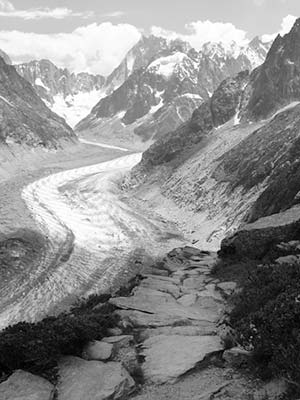
Here is an overview of this 2.5-hour hike: From the Aiguille du Midi lift, get off halfway down at Plan de l’Aiguille, sortie to the café/bar, then find signs leading down to Montenvers-Mer de Glace. Follow the main trail that is parallel to the gondola cables. You’ll drop steadily for 15 minutes down to a small refuge (good prices for meals and drinks), then go right, hiking the spectacularly scenic, undulating, and (for short periods) strenuous trail to Montenvers (overlooking the Mer de Glace glacier). Plan on lots of boulder-stepping and occasional stream crossings.
After about an hour at a steady pace, the trail splits. Follow signs up the steep trail to Le Signal (more scenic and easier), rather than to the left toward Montenvers (looks easier, but becomes very difficult). At this point, you’ll grind it out up switchbacks for about 30 minutes to the best views of the trail at Le Signal. Savor the views you worked so hard to reach. From here, it’s a long, sometimes steep, but always memorable drop to Montenvers and the Mer de Glace. In Montenvers, take the train back to Chamonix. Don’t walk the rest of the trail down from Montenvers (long, steep, disappointing views).
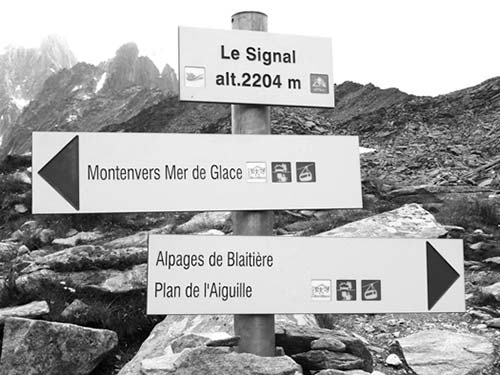
This lovely hike undulates for two and half hours above Chamonix Valley, with staggering views of Mont Blanc and countless other peaks, glaciers, and wildflowers. There’s just 370 feet of difference in elevation between the La Flégère and Planpraz lift stations—so this hike, though not without its ups and downs, is doable (but still requires serious stamina and appropriate shoes). The trail is a mix of dirt paths, ankle-twisting rocky sections, and short stretches of service roads. You’ll pass by winter lifts and walk through meadows and along small sections of forest. Keep your eyes out for green-lettered signs to La Flégère or Planpraz, depending on your direction; red-and-white markers also help identify the trail.
You can hike the trail in either direction. If you start at La Flégère, Mont Blanc stays in your sights the entire walk. Ask for the round-trip rate when you combine La Flégère and Planpraz (Le Brévent) lifts, available at either lift (saves about €6). Remember that these lifts are closed from late April to mid-June and again by mid-September.
To start at La Flégère, take free bus #1, #2, or #21 (all buses use Chamonix Sud and Centre stops, get departure times and stop locations to Les Praz/La Flégère at TI or at www.chamonix-bus.com; see here), or walk 40 minutes along the Arve River to Les Praz (see Hike #5, described later). Take the lift up to La Flégère, and walk out the back (to near the snack stand) and get your bearings. Find the dirt path of the Mer de Glace glacier and the cliff-hanging Hôtel du Montenvers on the opposite side of Chamonix’s valley. To find the trail for your hike, walk down to the refuge just below the lift station and turn right, crossing under the gondola cables to Planpraz (you don’t want Les Praz-Chamonix—that’s straight down). Signage is inconsistent, so expect to do some route-finding along the way. End your hike at Planpraz station, the midway stop on the Le Brévent lift line, and return to Chamonix from there.
If starting from the Le Brévent lift, take the télécabine up to Planpraz (automated cars leave every minute). As you ride up with your back to Mont Blanc, you may spot your destination lift station (La Flégère) off to the right. From the Planpraz lift station, leave the station, walking behind it (not past La Bergerie Restaurant), then climb above, following green-lettered signs to La Flégère. When you reach the La Flégère lift, ride it down to Les Praz (the hike down is not worth the trouble), then walk back to Chamonix following Hike #5 (described later), or take any of the free Chamonix buses that stop on the main road at the entrance to the La Flégère lift station (about 4/hour, 10-minute ride; see here for bus details).
This is the most demanding hiking trail of those I list; it climbs steeply and steadily over a rough, boulder-strewn trail for 1.5 hours to snowy Lac Blanc (pronounced “lock blah”). Some footing is tricky, and good shoes or boots are a must. I like this trail, as it gets you away from the valley edge and opens views to peaks you don’t see from other hikes.
The destination is a snow-white lake framed by peaks and the nifty Refuge-Hôtel du Lac Blanc, which offers good lunches (and dinners, if you stay the night, summers only). The views on the return trip are breathtaking. Check for snow conditions on the trail (often a problem until July) and go early (particularly in summer), as there is no shade and this trail is popular.
Follow the directions for Hike #2 to La Flégère station, then walk out the station’s rear door past the snack stand to get oriented. Track the trail as it drops way down to that winter chairlift station, then hooks hard left back up a steep hill. You can avoid this considerable down-and-up by taking the L’Index chairlift behind you (about €9 one-way, €11 round-trip, €27 from the base). Make sure the trail from L’Index is free of snow, as this shortcut can be dicey, especially for kids. However you start, the trail is well-signed to Lac Blanc, and its surface improves as you climb.
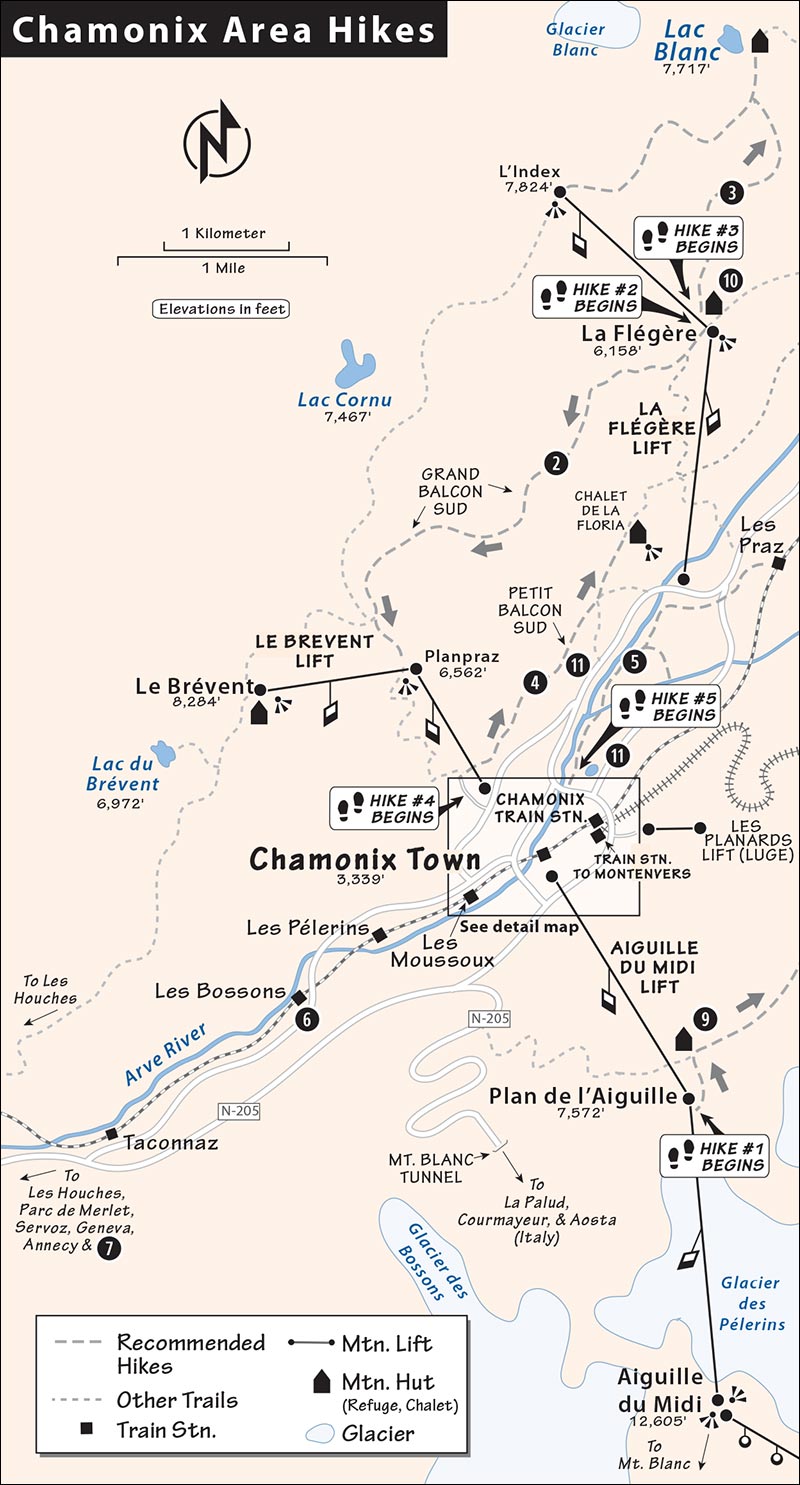
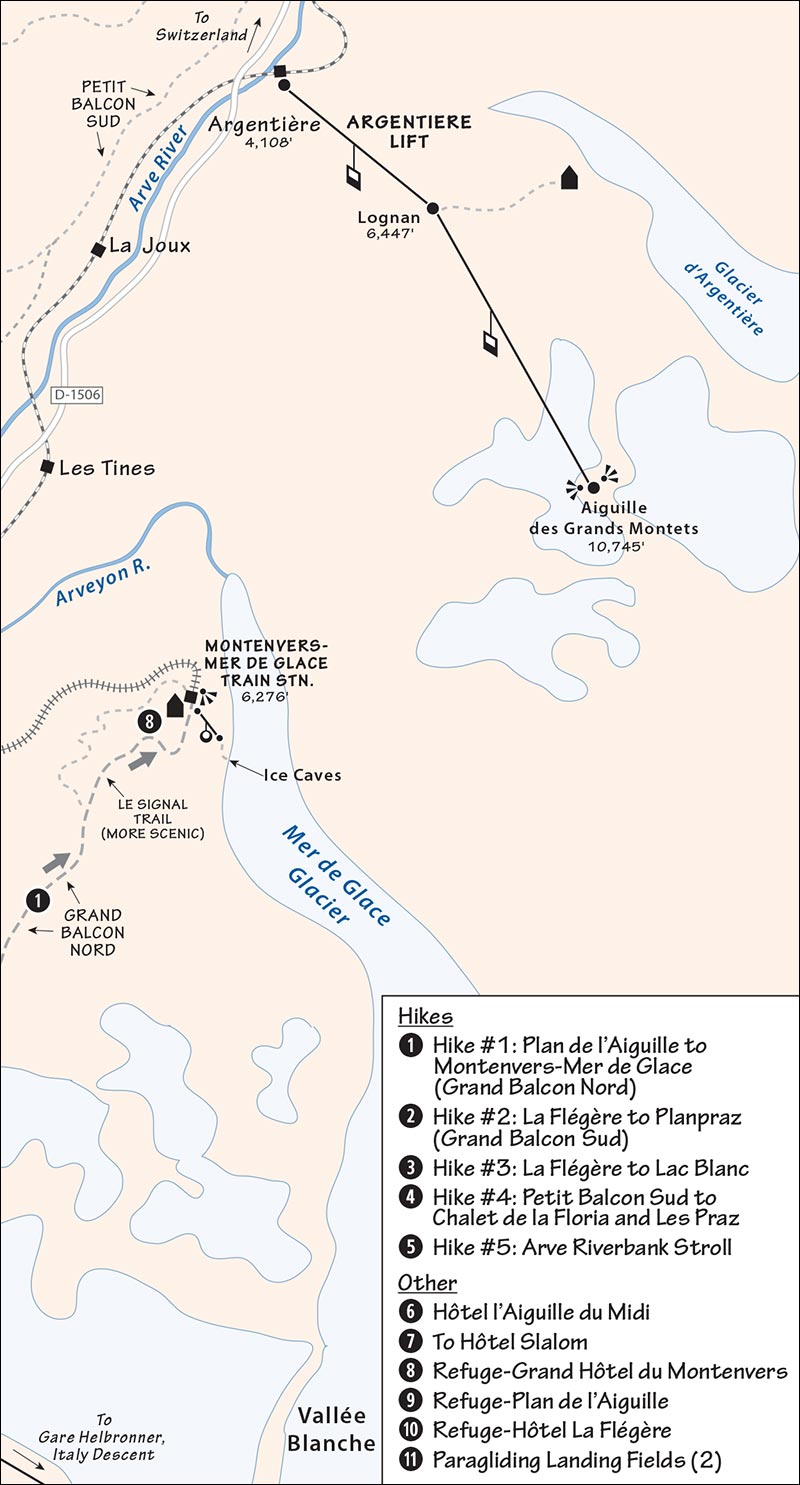
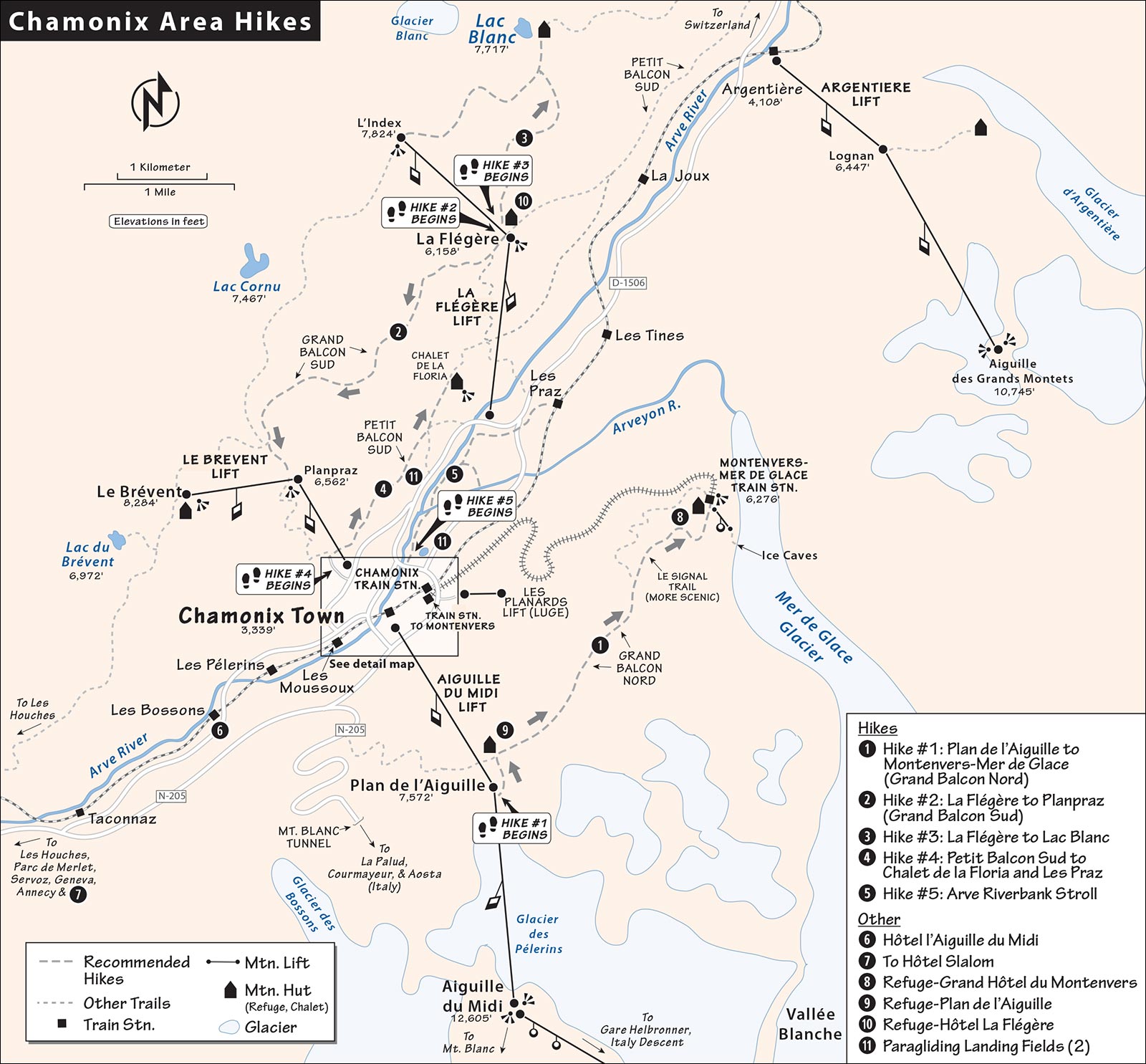
This trail runs above the valley on the Brévent side from the village of Les Houches to Argentière, passing Chamonix about halfway, and is handy when snow or poor weather make other hikes problematic. No lifts are required—just firm thighs to climb up and down. Access paths link the trail to villages below. Once you’re up, the trail rises and falls with some steep segments and uneven footing. The highlight of the trail is flower-covered Chalet de la Floria snack bar (allow one hour each way from Chamonix).
Reach the trail from Chamonix by starting at the Le Brévent lift station (find signs to Le Petit Balcon Sud). Begin by walking along an asphalt road to the left of the lift leading uphill (on Chemin de la Pierre à Ruskin), which turns into a dirt road marked as the Petit Balcon Sud trail. After about 20 minutes on the dirt road, you’ll see a Petit Balcon Sud sign pointing left and up a smaller trail. Bypass this turnoff (which doubles back above Chamonix with great views) and continue along the dirt road.
After about 30 more minutes, follow la Floria signs on a 20-minute round-trip detour to Chalet de la Floria, which has drinks, snacks, flowers, and magnificent views (daily mid-June-mid-Oct). From here, the trail continues above Les Praz to the north; junction trails lead back down to Chamonix or to Les Praz village. Following the junction trail to Les Praz eventually lands you on the main road; turn left to explore the village and to connect with the river trail back to Chamonix (the trail is immediately to the right after the bridge), or turn right on the road to reach the bus stop back to Chamonix (it takes bus #1 about 20 minutes to reach Les Praz from the time point posted in Le Tour; bus #2 starts a minute away at the Les Praz/La Flégère lift, and bus #21 starts about 17 minutes away at Col des Montets).
For a level, forested-valley stroll, bike ride, or jog, follow the Arve River toward Les Praz. At Chamonix’s Hôtel Alpina, follow the path upstream past Chamonix’s middle school, red-clay tennis courts, and find the green arrow to Les Praz. You’ll cross a few bridges to the left, turn right along the rushing Arve River, and then follow Promenade des Econtres. Several trails loop through these woods; if you continue walking straight, you’ll reach Les Praz in about an hour—an appealing destination with a number of cafés and a pleasing village green.
If you keep right after the tennis courts (passing piles of river sediment dredged to deter flooding), you’ll come to a grassy landing field, signed Parapente, where paragliders hope to touch down. Walk to the top of the little grassy hill for fine Mont Blanc views and a great picnic spot.
Here’s something for thrill-seekers: Ride a chairlift up the mountain and then scream down a twisty, banked, slalom course on a plastic sled on rails. Chamonix has two roughly parallel luge courses: While each course is just longer than a half-mile and about the same speed, one is marked for slower sledders, the other for speed demons. Young or old, hare or tortoise, any fit person can manage a luge. Freinez signs tell you when to brake. The luge courses are set in a grassy park with kids’ play areas.
Cost and Hours: One ride-€5.50, €7.50 for double sled; six rides-€31, €40 for double sled; kids under age 8 must ride with adult, entry includes all activities in Parc de Loisirs des Planards—see “Kids’ Activities” on here; generally July-Aug daily 10:00-18:30, mid-April-June and Sept-Oct Sat-Sun and select weekdays 13:30-18:00, check website for hours; 15-minute walk from town center, over the tracks from train station and past Montenvers train station; tel. 04 50 53 08 97, www.chamonixparc.com.
When it’s sunny and clear, the skies above Chamonix sparkle with colorful parachute-like sails that circle the valley like birds of prey. For €100-110 plus the cost of the lift up to Planpraz (Le Brévent ski area) or Plan de l’Aiguille, you can launch yourself off a mountain in a tandem paraglider with a trained, experienced pilot and fly like a bird for about 20 minutes (true thrill-seekers can launch from Aiguille du Midi, €240, 40-minute ride). Most pilots will meet you at the lift station in Chamonix (usually from Le Brévent side, as it has the most reliable conditions, though you can ask them to fly you from Plan de l’Aiguille if you’ll be there anyway and are pressed for time—not possible July-Aug). Sean Potts is English (no language barrier) and easy to work with (info@fly-chamonix.com). You can also try Summits Parapente (smart to reserve a day ahead, open year-round, tel. 04 50 53 50 14, mobile 06 84 01 26 00, www.summits.fr).
For a sneak preview, walk to one of the two main landing areas and watch paragliders perfect their landings (see “Chamonix Area Hikes—Hike #5,” earlier).
If the weather disagrees with your plans, stay cool and check out the following options.
Situated in one of Chamonix’s oldest “palaces,” this place has good exhibits about Chamonix’s evolution from a farming area to one focused on skiing. The museum shows off Chamonix’s mountaineering, skiing, and mineralogical history (explanations in French only) and has exhibits on the first Winter Olympics, held right here.
Cost and Hours: €5.50, July-Aug daily 10:00-12:00 & 14:00-18:00, otherwise from 14:00 and closed on Tue, 89 Avenue Michel Croz, tel. 04 50 53 25 93.
The Espace Tairraz has two parts: a fascinating collection of crystals from all over the world in every color, shape, and size, and a good section on mountaineering (English information posted). You’ll become one with a climber and experience some of the best local ascents via video footage. The interactive climbing simulator is a hit with children and adults alike.
Cost and Hours: €5.50, daily 14:00-18:00 plus 10:00-13:00 in July-Aug, 615 Allée Recteur Payot, tel. 04 50 55 53 93, www.cc-valleedechamonixmontblanc.fr—choose “Culture” and “Musées.”
Chamonix’s most celebrated nature photographer displays his mesmerizing photographs of the scenery high above you. These are so good you may not miss seeing the real thing.
Cost and Hours: Free, daily 10:00-12:30 & 15:00-19:30, open during lunch in July-Aug, a block from the train station at 19 Rue Whymper, www.mario-colonel.com.
Plenty of tempting alpine and cultural thrills await just an hour or two away in Switzerland. A scenic road and rail route sneaks you from Chamonix to the Swiss town of Martigny. Train travelers cross without formalities, but drivers are charged a one-time fee of 40 Swiss francs (about €34) for a permit, known as a vignette, to use Swiss autobahns.
The remote Valle d’Aosta and its historic capital city of Aosta offer a serious change of culture. The side-trip is worthwhile if you’d like to taste Italy (spaghetti, gelato, and cappuccino), enjoy the town’s great evening ambience, or view the ancient ruins in Aosta (often called the “Rome of the North”).
Getting There: Take the spectacular lift (Aiguille du Midi–Helbronner—described on here) to Italy. From Helbronner, ride the Skyway Monte Bianco lift, which stops at Pavillon du Mont Fréty on its way down to Pontal d’Entrèves (www.montebianco.com). It’s an amazing ride—the gondola rotates 360 degrees as you sail along. From Pontal d’Entrèves, you can take the bus to Aosta (hourly, change in Courmayeur). Aosta’s train station has connections to anywhere in Italy (about every 2 hours, usually on slow trains via Turin).
For a more down-to-earth experience, you can take the bus from Chamonix to Aosta via the Mont Blanc Tunnel (about €19 one-way, €30 round-trip, reservation required in summer, 5/day July-mid-Sept, 3/day mid-Sept-June, 2 hours). Get schedules at the SAT ticket office at 13 Avenue Michel Croz, near the Alpine Museum (tel. 04 50 53 01 15, www.sat-montblanc.com) or in summer at Chamonix’s bus station, 234 Avenue de Courmayeur, close to the bowling alley. Drivers can travel straight through the Mont Blanc toll tunnel (one-way-€44, round-trip-€55 with return valid for 1 week, www.tunnelmb.com).
Reasonable hotels and dorm-like chalets abound in Chamonix, with easy parking and quick access from the train station. The TI can help you find budget accommodations anytime—either in person or by email (reservation@chamonix.com). Outside winter, mid-July to mid-August is most difficult, when some hotels have five-day minimum-stay requirements. Very few hotels offer air-conditioning but most have elevators. Prices tumble off-season (outside July-Aug and Dec-Jan). Many hotels and restaurants are closed in May, June, and November, but you’ll still find a room and a meal. If you want a view of Mont Blanc, ask for côté Mont Blanc (coat-ay mohn blah). Travelers who visit June through September should contemplate a night high above in a refuge-hotel.
Price ranges usually reflect low-to-high season rates (low season is roughly March-June and Sept-Nov). Ask at your hotel about the free Chamonix Guest Card, which provides complimentary use of most buses and trains during your stay (described on here).
$$$ Hôtel Hermitage****, a 10-minute walk from the town center, is a gorgeous chalet hotel with the coziest lounges in Chamonix and a lovely garden with good kids’ areas (swings, slides, ping-pong). It has a small bar (great stools), a small sauna, and 30 alpine-elegant rooms, all with balconies and reasonable prices considering the quality (Db-€140-160, larger rooms with Mont Blanc view-€160-260, Tb-€171-196, big family rooms and suites-€283-375, breakfast-€17, easy parking, closed mid-Sept-mid-Dec and mid-April-mid-June, near train station at 63 Chemin du Cé, tel. 04 50 53 13 87, www.hermitage-paccard.com, info@hermitage-paccard.com).
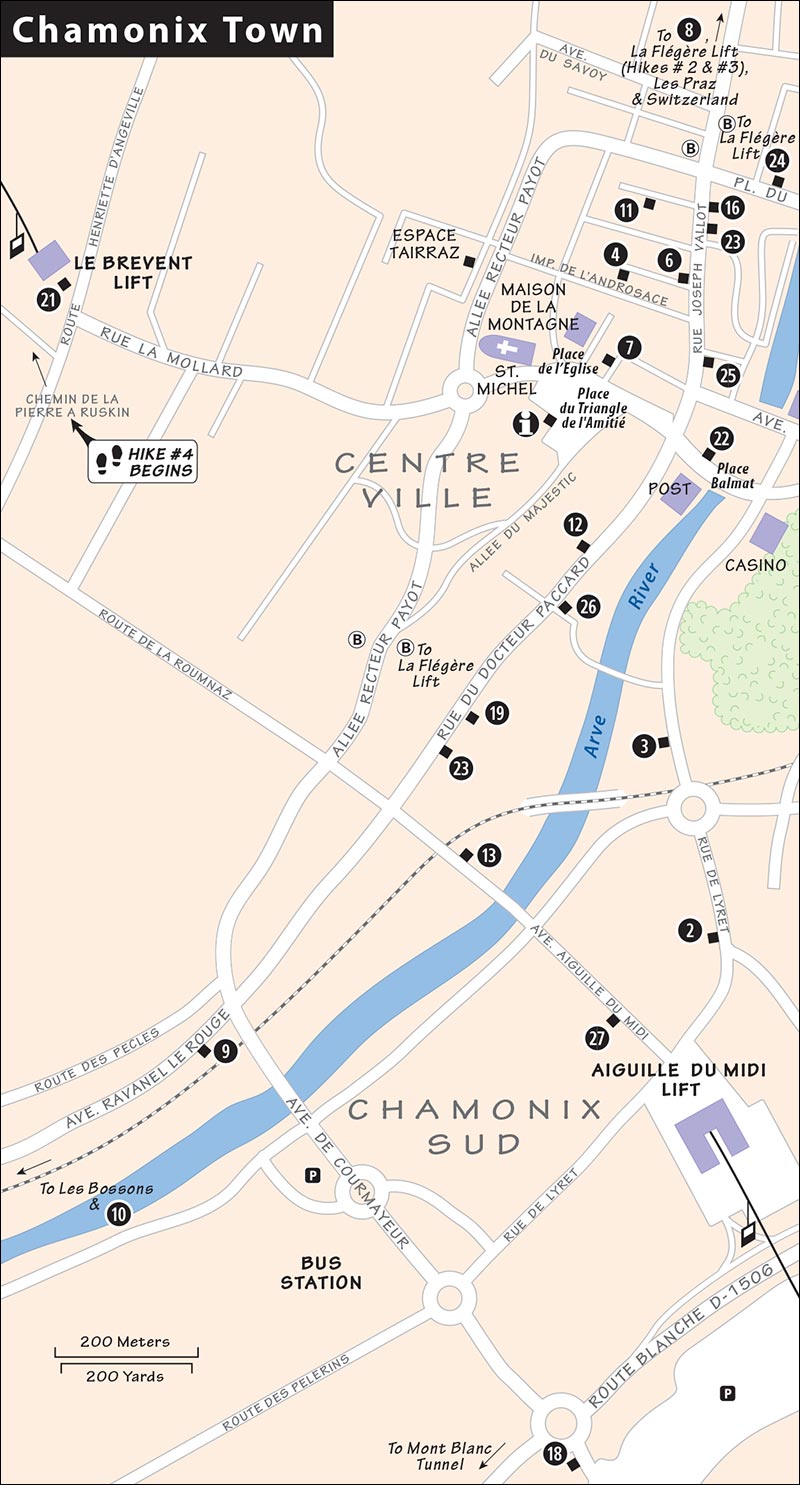
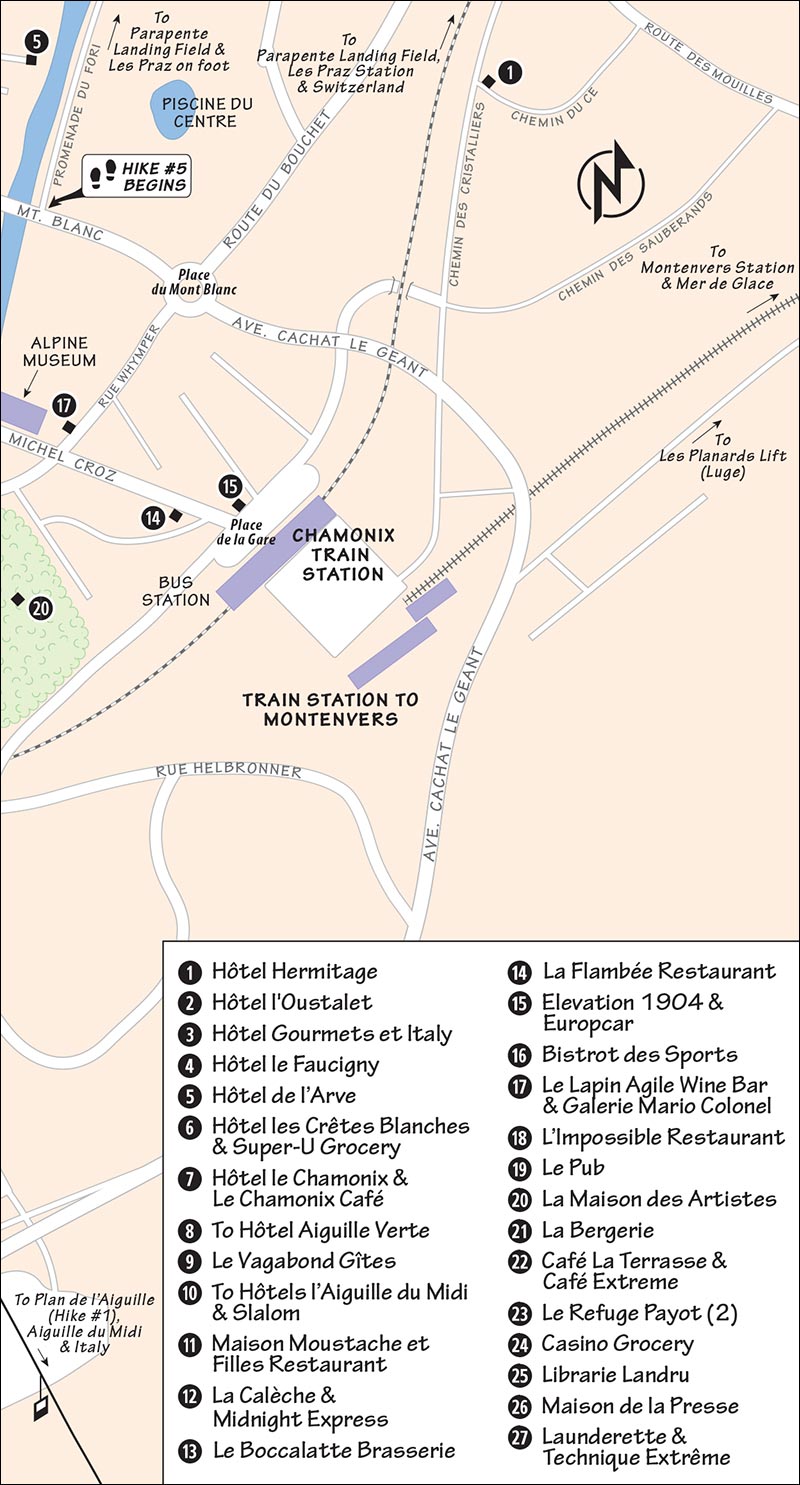
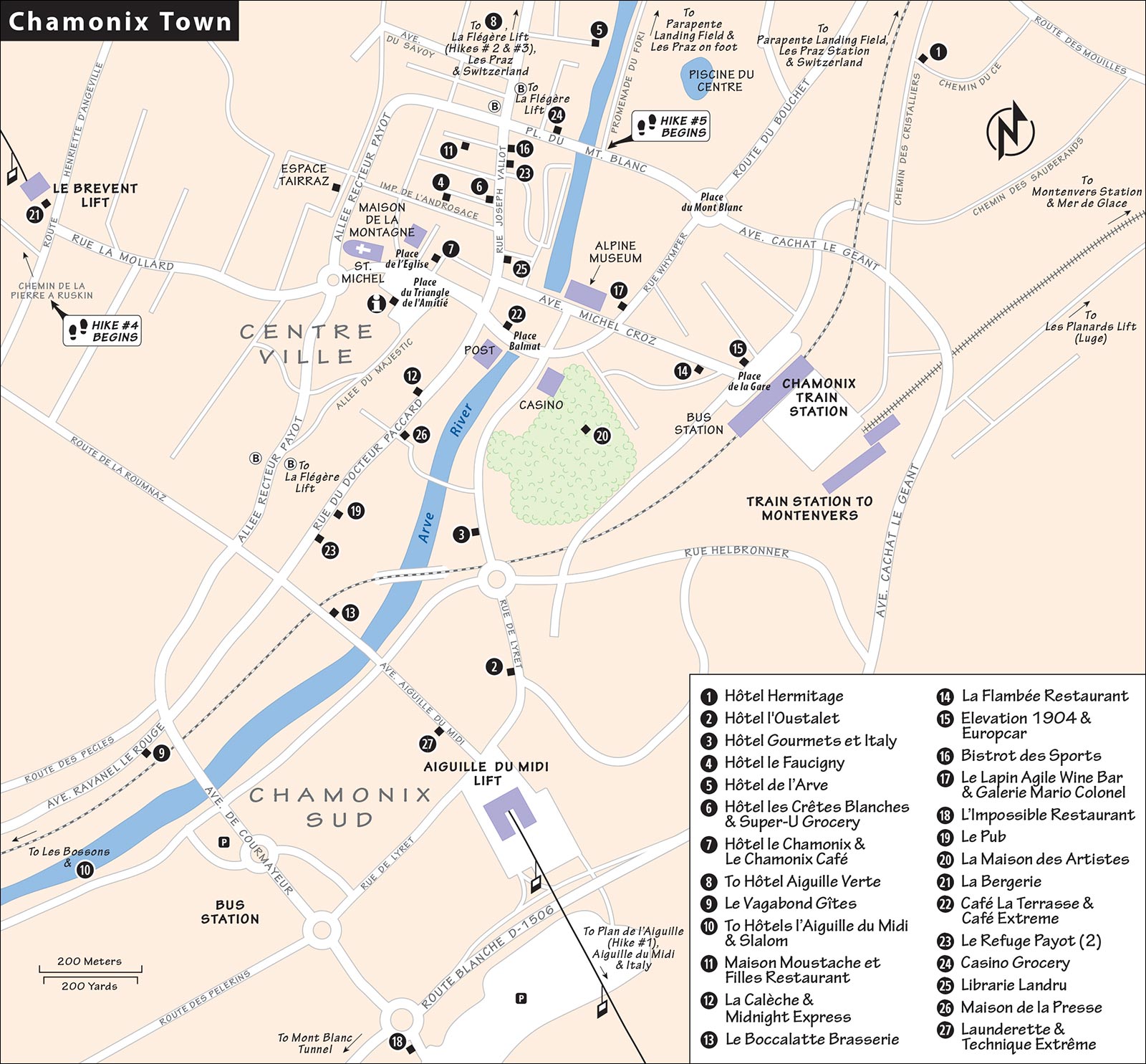
$$$ Hôtel l’Oustalet*** is a chalet hotel that makes me feel like I’m in Austria. It’s warmly run by two sisters (Véronique and Agnès), who understand the importance of good service. The place is family-friendly, with lots of grass, a big pool, and six family suites. All rooms are wood-paneled, with views and balconies (standard Db-€142, bigger Db with terrace-€160, Qb family rooms-€198, terrific breakfast-€14, try the teurgoule rice pudding, sauna and Jacuzzi, free and secure parking, near Aiguille du Midi lift at 330 Rue du Lyret, tel. 04 50 55 54 99, www.hotel-oustalet.com, infos@hotel-oustalet.com).
$$$ Hôtel Gourmets et Italy*** is a 36-room place with comfy public spaces, a cool riverfront terrace, balcony views from many of its appealing rooms, and a small pool (standard Db with shower-€110-130, larger Db with bath and Mont Blanc view-€130-160, a few good family rooms, extra person-€15, closed late April-early June and Nov, 2 blocks from casino on Mont Blanc side of river, 96 Rue du Lyret, tel. 04 50 53 01 38, www.hotelgourmets-chamonix.com, info@hotelgourmets-chamonix.com).
$$$ Hôtel le Faucigny*** is a peaceful, polished place with a Scandinavian feel and a welcoming vibe. This full-service hotel offers free loaner bikes, sauna and Jacuzzi, and afternoon tea and treats in the linger-longer lounge. The front terrace provides a tranquil retreat with mountain views, and rooms are bright and tight but comfortable (Db-€110-180, Tb-€130-220, family rooms-€170-240, great breakfast-€12, 118 Place de l’Eglise, tel. 04 50 53 01 17, www.hotelfaucigny-chamonix.com, reservation@hotelfaucigny-chamonix.com).
$$ Hôtel de l’Arve*** offers midrange comfort with a contemporary alpine feel in its 37 rooms, some right on the Arve River looking up at Mont Blanc. This hotel comes with a fireplace lounge, a pool table, a pleasant garden, a sauna, a climbing wall, and easy parking. Check their website for deals like a cheaper breakfast (huge fluctuation in prices, but here’s a best guess: standard Db-€80-110, larger or view Db-€100-135, family room for up to 4-€140-190, extra person-€15, several “apartments” ideal for families, good breakfast-€12, private parking, around the corner from huge Hôtel Alpina, 60 Impasse des Anémones, tel. 04 50 53 02 31, www.hotelarve-chamonix.com, contact@hotelarve-chamonix.com).
$$ Hôtel les Crêtes Blanches*** is a central and sweet little place wrapped around a peaceful courtyard (with outdoor tables) just off Rue Joseph Vallot. Rooms are smallish and well-designed, with appealing wood paneling; all come with views of Mont Blanc and most have small balconies (Db-€80-115, superior Db-€92-130, Tb-€100-158, Qb-€115-168, highest prices are mid-July-Aug, adorable Quint/b dollhouse-sized chalet with kitchen-€133-215, breakfast-€10, 6 Impasse du Génépy, tel. 04 50 53 05 62, www.cretes-blanches.com, cretes-blanches-chamonix@wanadoo.fr).
$$ Hôtel le Chamonix**, across from the TI and above a café, is simple, with 16 paneled rooms at fair rates and no elevator. The rooms facing Mont Blanc have great views, are larger and brighter, and have little balconies...but also attract noise from le café below, which closes at 22:00 (Db-€70-114, Tb-€90-130, Qb-€105-150, higher prices are for rooms with view and balcony, breakfast-€9, 11 Rue de l’Hôtel de Ville, tel. 04 50 53 11 07, www.hotel-le-chamonix.com, hotel-le-chamonix@wanadoo.fr).
$ Hôtel Aiguille Verte* provides simple one-star comfort at appropriate prices in a creaky 12-room chalet a 10-minute walk from the center of town, toward the village of Les Praz. Rooms are clean, but may need a bit of refreshing, and many have small balconies (Db-€66-80, 633 Rue Joseph Vallot, tel. 04 50 53 01 73, mobile 06 33 04 12 76, hotel-aiguilleverte@orange.fr).
$ Le Vagabond Gîtes offers the best cheap digs in Chamonix in a fun chalet just south of the town center. Dorm rooms have four to six bunks, with basic showers and toilets down the hall; all rooms have sinks. The top floor has one family room. The owner is Welsh, the staff is a mix of other British expats, and the feel is relaxed, with a bar and outside terrace (Bunk in dorm room-€30-35, Db-€75-100, family Qb-€115, includes breakfast, one-time €5.50 charge for linens in dorm, reception closed 10:00-16:30, 305 Avenue Ravanel le Rouge, tel. 04 50 53 15 43, www.gitevagabond.com, info@vaga.eu).
If Chamonix overwhelms you, spend the night in one of the valley’s often-overlooked, lower-profile villages.
$$$ Hôtel l’Aiguille du Midi***, a mountain retreat, lies in the village of Les Bossons, about two miles from Chamonix toward Annecy. It’s run by the English-speaking Farini family in a park-like setting with point-blank views of Mont Blanc and the Bossons Glacier. This family-friendly place has a swimming pool, a clay tennis court, table tennis, a massage room, and a laundry room to boot. Half of the alpine-comfortable rooms come with modern bathrooms, many have decks with views, and several are good for families. The classy restaurant offers à la carte and menu options, with menus from €25 (Db-€100-156, Tb-€136-178, Qb-from €180-198, ask for these special Rick Steves rates when you reserve, elevator, easy by train, get off at Les Bossons, tel. 04 50 53 00 65, www.hotel-aiguilledumidi.com, info@hotel-aiguilledumidi.com).
$$ Hôtel Slalom in nearby little Les Houches makes a lovely, contemporary mountain base for hikers looking for more tranquility. The town has all amenities and is served by train. The rooms and public spaces are stylish, and the owners are welcoming (Db-€100, Tb-€115, 44 Rue de Bellevue, closed mid-April-mid-June and mid-Oct-early-Dec, tel. 04 50 54 40 60, www.hotelslalom.net, info@hotelslalom.net).
Chamonix has the answer for hikers who want to sleep high above, but aren’t into packing it in: refuge-hotels (generally open mid-June to mid- or late September, depending on snow levels). Refuge-hotels usually have some private rooms (but mostly dorm rooms), hot showers down the hall, and restaurants. Most expect you to take dinner and breakfast there (a great value). Reserve in advance (a few days is generally enough), then pack a small bag for a memorable night among new international friends. The Office de Haute-Montagne in Chamonix can explain your options (see here).
$ Refuge-Grand Hôtel du Montenvers, Chamonix’s oldest refuge, delivers an Old World experience at the Montenvers train stop. It was built in 1880 as a climbing base for mountain guides before the train went there, so materials had to be gathered from nearby. The 12 simple wood-cozy rooms, top-floor dorm room (30 beds), and dining room feel as though they haven’t been modified since then (open July-Aug only, half-pension in a double room-€67/person, in a dorm room-€47/person, reserve online, good showers down the hall for all, tel. 04 50 53 14 14, www.compagniedumontblanc.fr). For directions, see “Hike #1” on here.
$ Refuge-Plan de l’Aiguille is my favorite refuge experience near Chamonix. It’s a small, welcoming, easy-to-reach refuge a 15-minute walk below the Plan de l’Aiguille lift, right on the trail between the Aiguille du Midi and Montenvers-Mer de Glace. It has a warm interior and a killer view café. The friendly cook and guardian Claude is a retired pastry chef, so the meals are good and the desserts heavenly (open May-Oct only, €22/bed, half-pension-€50/person, towel-€2.50, mobile 06 65 64 27 53, claudius74@hotmail.com).
$ Refuge-Hôtel La Flégère hangs on the edge right at the La Flégère lift station. It’s simple and big, but ideally located for hiking to Lac Blanc or Planpraz (open mid-June-mid-Sept only, dorm rooms with 5-42 beds, required half-pension-€56/person, fireplace, cool bar-café, mobile 06 03 58 28 14, bellay.catherine@wanadoo.fr). For directions, see “Hike #2” on here.
You have two basic dining options in Chamonix—cozy, traditional savoyard restaurants serving fondue, raclette, and the like, or cafés in central locations serving a wide variety of dishes (including regional specialties) that allow you to watch rivers of hikers return from a full day in the mountains. Prices are roughly the same. If it’s a beautiful day, take an outdoor table at a central café (see the “View Cafés” section); if you’re dining inside, go local and consider a place in or near the town center (most are closed between lunch and dinner). The regional cuisine is hearty and filling, as restaurants seek to satisfy ravenous hikers.
(See “Chamonix Town” map, here.)
Maison Moustache et Filles is named for the mustachioed owner whose daughter (fille) runs the place. It boasts a fun, ski-festooned interior, terrific outdoor patio, and tasty cuisine at reasonable prices. Locals love it, and the duck is delectable (€14-24 plats, €30 menu, €10 kid’s menu with good burgers, closed Mon, 37 Impasse des Rhododendrons, tel. 04 50 93 49 68).
La Calèche presents tasty regional dishes in a warm, hyper-decorated alpine setting (pass on the outside seating). You’ll dine amid antique dolls, cuckoo clocks, copper pots, animal trophies, and more (find the luge sled from the 1924 Olympic Games). Try the potée savoyarde in winter (sausages with melted cheese) or meats grilled at your table on hot stones (la pierre chaude). Don’t leave without a visit to the WCs (€25 menu, the €30 menu is much better, daily, centrally located just off Place Balmat at 18 Rue du Docteur Paccard, tel. 04 50 55 94 68).
Le Boccalatte Brasserie, with a convivial atmosphere inside and out, serves a good-value lunch or dinner a few blocks above the Aiguille du Midi lift. The place is family-friendly and easygoing. The €16 tartiflette with salad will fill your belly, or choose from a large selection of other local specialties, big €11 salads, good pizzas, and 20 kinds of beer. It’s run by English-speaking Thierry, a friendly Alsatian (daily 12:00-22:00, 59 Avenue de l’Aiguille du Midi, tel. 04 50 53 52 14).
La Flambée offers reasonable prices in a lively mosh pit of alpine paraphernalia served by a lighthearted staff. They cook up everything from burgers to pizza to fondue to steaks (€15-20 plats, €10-14 pizza or pasta dishes, closed Mon, a block from the train station at 232 Avenue Michel Croz, tel. 04 50 54 12 96).
Budget Meals: Elevation 1904 is a down-and-dirty climbers’ haunt across from the train station, serving cheap and tasty sandwiches, burgers, pasta, and salads (daily until about 22:00, Wi-Fi, 263 Avenue Michel Croz). Bistrot des Sports dishes cheap plats du jour and menus amid a cacophony of noise in the back of their lively bar (daily, 176 Rue Joseph Vallot). Midnight Express serves good sandwiches until late and has a few outside tables across from the recommended La Calèche restaurant. Try a pain en rond (round-bread rustic sandwich), served hot (chaud) or cold (froid).
Drinks: If a pre-dinner glass of wine from anywhere in the world sounds appealing, hop on into little Le Lapin Agile for cozy ambience and a happy-hour buffet of finger foods—free if you purchase a drink (closed Mon, a block from the train station at 11 Rue Whymper, tel. 04 50 53 33 25).
(See “Chamonix Town” map, here.)
L’Impossible, housed in a beautiful farmhouse a 10-20-minute walk from most recommended hotels, is the place to go for refined organic cuisine with an Italian bias. Bring your food allergies: This place offers gluten–free, lactose-free, and fat-free (well, maybe not that) dishes without sacrificing flavor. Even if eating healthfully doesn’t boost your boots, you’ll appreciate the exquisite meals and attention to detail. Papa (who hails from Tuscany) cooks, while Mama serves (€17-28 plats, €32-62 menus, closed on Tue except in Aug, 5-minute walk from Aiguille du Midi lift on Route des Pélerins, tel. 04 50 53 20 36).
Après Hike: The Bistrot des Sports is where locals hang their ice picks after a hard day in the mountains. Drinks are cheap, the crowd is loud, and the ambience works (see “Budget Meals,” earlier). Le Pub is a good spot to raise a glass with the British crowd (225 Rue du Docteur Paccard, tel. 04 50 55 92 88). La Maison des Artistes, located in the park behind the casino, is the latest addition to the music scene in Chamonix. Started by popular French musician André Manoukian, it has a recording room and free concerts, mainly jazz (daily in summer, 84 Chemin de la Tournette, www.maisondesartistes.eu).
View Cafés: High above Chamonix, many cafés excel in outdoor views, but here are several that I think stand above the rest. La Bergerie, at Planpraz station on Le Brévent, is hard to beat and offers surprisingly affordable drinks, snacks, and meals, as does the Refuge-Plan de l’Aiguille below Mont Blanc (15-minute walk from Plan de l’Aiguille lift station, described earlier under “Sleeping in Chamonix”). Back down in Chamonix, facing the TI a block off the action-packed pedestrian core, scenic Le Chamonix Café sits below Chamonix’s pretty little church and has terrific views of both mountain ranges (daily until 22:00, Place de l’Eglise). Café La Terrasse has a cool location (literally) above the rush of the Arve River and is well-positioned for Mont Blanc views (daily until late, across from the casino on Place Balmat). Café Extreme is a relaxed place for cheap food and lovely views of the main square and mountains (daily, 31 Place du Joseph Balmat, tel. 04 50 21 99 45).
Bus and train service to Chamonix is surprisingly good. Some train routes pass through Switzerland to reach Chamonix (such as from Paris and Colmar) and require supplements if you have a France-only rail pass. You can avoid passing through Switzerland if you plan ahead, but it usually takes longer, and you miss some great scenery. The route to Colmar (via Bern and Basel) is beautiful and costs roughly €60 for the Swiss segment. You’ll get a fun taste of Switzerland’s charms, and, though you’ll make many transfers en route, they all work like a Swiss clock.
Chamonix recently moved its bus station to a parking lot near the Aiguille du Midi lift station at 234 Avenue de Courmayeur. However, the ticket office at the bus station is only open in July and August (daily 8:15-12:15 & 13:15-18:15). From September to June, buy tickets at the SAT office at 13 Avenue Michel Croz, near the Alpine Museum (Sun-Fri 8:00-12:00 & 14:30-18:30, Sat 8:00-10:00 & 15:00-18:00, tel. 04 50 53 01 15, www.sat-montblanc.com).
From Chamonix by Train to: Annecy (11/day, 2.5 hours, change in St-Gervais), Beaune and Dijon (7/day, 6-7 hours, change in St-Gervais and Lyon, some require additional changes), Nice (4/day, 10 hours, change in St-Gervais and Lyon), Arles (5/day, 7-8 hours, change in St-Gervais and Lyon), Paris’ Gare de Lyon (7/day, more in summer and winter, 5.5-7 hours, some change in Switzerland), Colmar (hourly, 6 hours via Switzerland with 3-6 changes), Martigny, Switzerland (nearly hourly, 2 hours, scenic trip), Geneva, Switzerland, and its airport (roughly hourly, 3.5-5 hours, 2 changes).
From Chamonix by Bus to: Geneva Airport, Switzerland (2/day, about 2 hours), Courmayeur, Italy (3-5/day, 45 minutes, reservation required in summer), Aosta, Italy (3-5/day, 2 hours, reservation required in summer). For more on buses to Italy, see “Day Trips near Chamonix” on here.
Airport shuttles also provide service between Chamonix’s city center and the airport in Geneva, Switzerland (2 hours). Chamexpress is British-run and easy to work with (€35/person, €22 if booked in advance online, desk near arrival gate, www.chamexpress.com). You can also try Chamonix Taxis (www.chamonix-transfer.com).